Quality & Safety: Indicators of Organizational Performance
VerifiedAdded on 2023/06/04
|21
|5132
|226
Report
AI Summary
This report examines the critical role of quality and safety measures within healthcare institutions, with a specific focus on Alfred Hospital's efforts. It identifies key characteristics of useful quality indicators, including safety, effectiveness, appropriateness, acceptability, and accessibility, and dis...
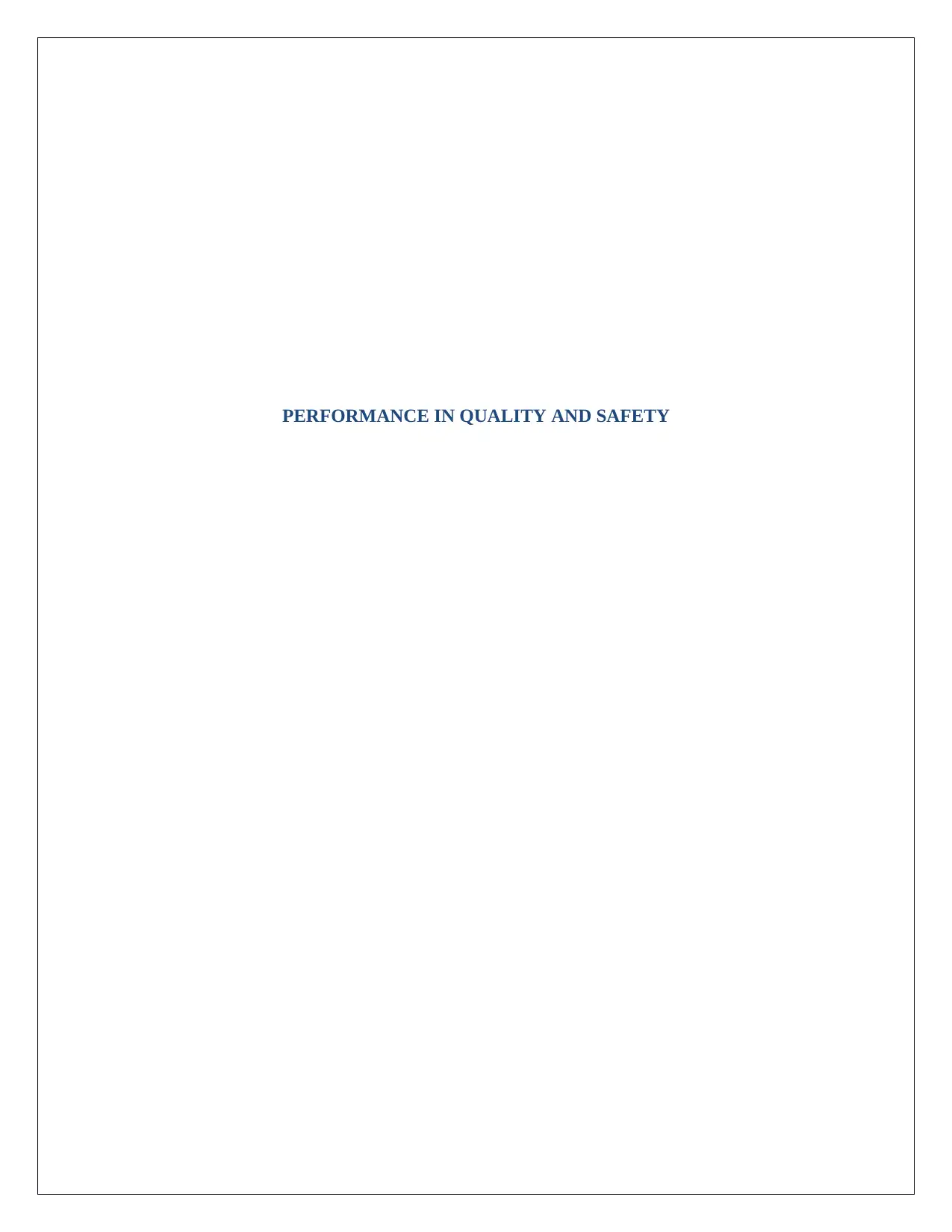
PERFORMANCE IN QUALITY AND SAFETY
Paraphrase This Document
Need a fresh take? Get an instant paraphrase of this document with our AI Paraphraser
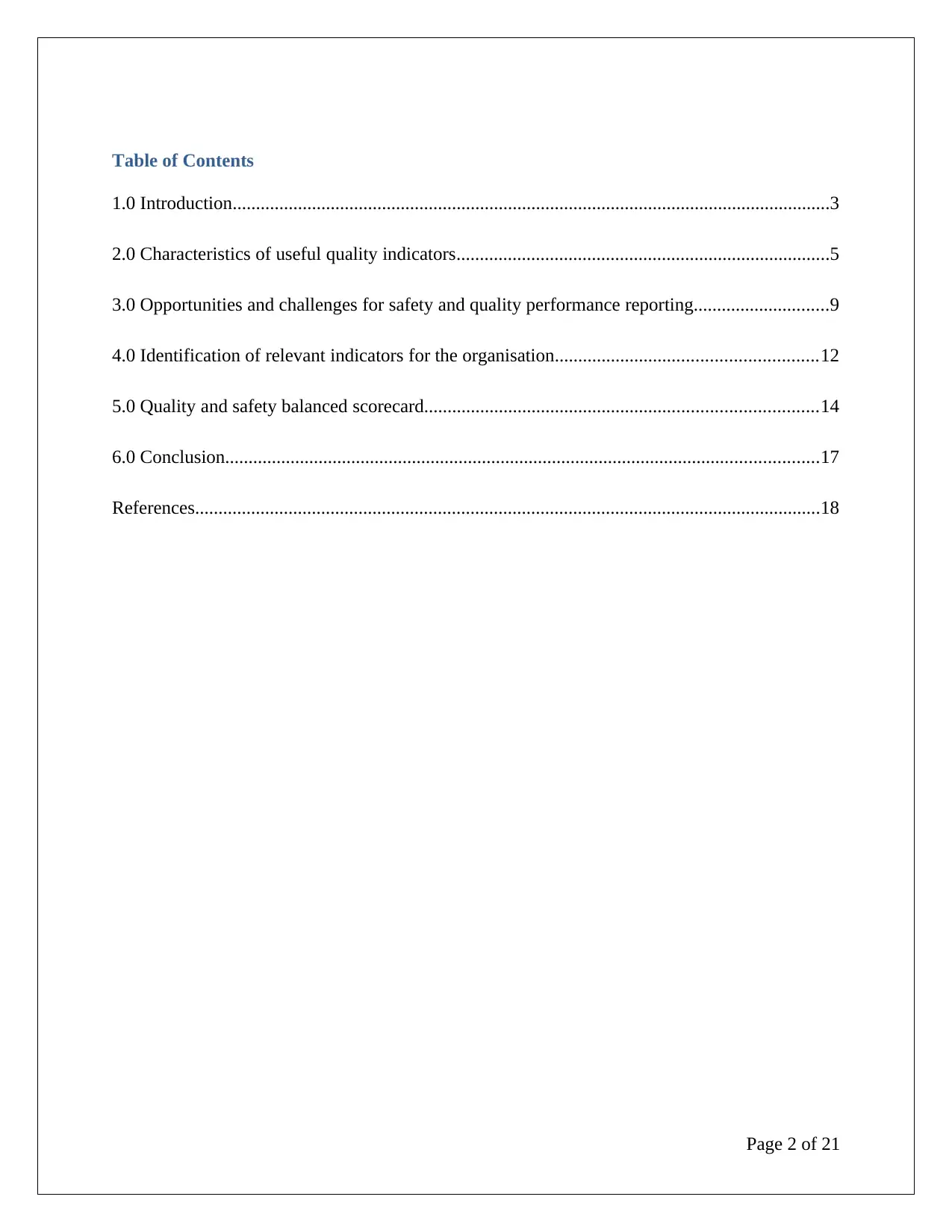
Table of Contents
1.0 Introduction................................................................................................................................3
2.0 Characteristics of useful quality indicators................................................................................5
3.0 Opportunities and challenges for safety and quality performance reporting.............................9
4.0 Identification of relevant indicators for the organisation........................................................12
5.0 Quality and safety balanced scorecard....................................................................................14
6.0 Conclusion...............................................................................................................................17
References......................................................................................................................................18
Page 2 of 21
1.0 Introduction................................................................................................................................3
2.0 Characteristics of useful quality indicators................................................................................5
3.0 Opportunities and challenges for safety and quality performance reporting.............................9
4.0 Identification of relevant indicators for the organisation........................................................12
5.0 Quality and safety balanced scorecard....................................................................................14
6.0 Conclusion...............................................................................................................................17
References......................................................................................................................................18
Page 2 of 21

1.0 Introduction
Quality and safety have become one of the most important aspects of the health care sector. With
the advancements of science and technology, quality improvement has become the most
effective aspect. In the consideration of Dixon-Woods & Martin (2016), the healthcare
institutions devoted to remedial practices require giving strong attempt for medical services.
Implementing dedicated practices for healthcare related settings, the doctors are required to
stream measurable enhancement in the eminence of medical services. According to White et al.
(2016), it can be noted that in the present time, patients are conscious of individual rights in
relation to medical services and the superiority of medical services are being conveyed to them.
There are several measures or indicators that are placed to offer the superiority of services for its
patients devoid of any obtained infection.
It can be stated that the primary reason behind the quality enhancement in the healthcare
institutions is that, in case the practices are stuck with any of the traditional concepts without any
further improvements, it might fail to generate effective results. Hence, it has been determined
that by streamlining the alterations into the system, a fresh degree of performance can be
attained. On the other hand, Graban (2016) stated that replacing the ineffective parts of the
structure with fresh inventions might turn up to be effective and worthy. For the established
effectiveness, advanced methodologies have been incorporated within the healthcare servicer on
the global context. Moreover, Dixon-Woods & Martin (2016) claimed that the digital version of
a patient's medical records renders the actual time records, which are patient centred by nature.
Several healthcare institutions are using EHR (Electronic Healthcare Records) software, which
contains the medical and treatment based histories of patients. The specific software is usually
Page 3 of 21
Quality and safety have become one of the most important aspects of the health care sector. With
the advancements of science and technology, quality improvement has become the most
effective aspect. In the consideration of Dixon-Woods & Martin (2016), the healthcare
institutions devoted to remedial practices require giving strong attempt for medical services.
Implementing dedicated practices for healthcare related settings, the doctors are required to
stream measurable enhancement in the eminence of medical services. According to White et al.
(2016), it can be noted that in the present time, patients are conscious of individual rights in
relation to medical services and the superiority of medical services are being conveyed to them.
There are several measures or indicators that are placed to offer the superiority of services for its
patients devoid of any obtained infection.
It can be stated that the primary reason behind the quality enhancement in the healthcare
institutions is that, in case the practices are stuck with any of the traditional concepts without any
further improvements, it might fail to generate effective results. Hence, it has been determined
that by streamlining the alterations into the system, a fresh degree of performance can be
attained. On the other hand, Graban (2016) stated that replacing the ineffective parts of the
structure with fresh inventions might turn up to be effective and worthy. For the established
effectiveness, advanced methodologies have been incorporated within the healthcare servicer on
the global context. Moreover, Dixon-Woods & Martin (2016) claimed that the digital version of
a patient's medical records renders the actual time records, which are patient centred by nature.
Several healthcare institutions are using EHR (Electronic Healthcare Records) software, which
contains the medical and treatment based histories of patients. The specific software is usually
Page 3 of 21
You're viewing a preview
Unlock full access by subscribing today!
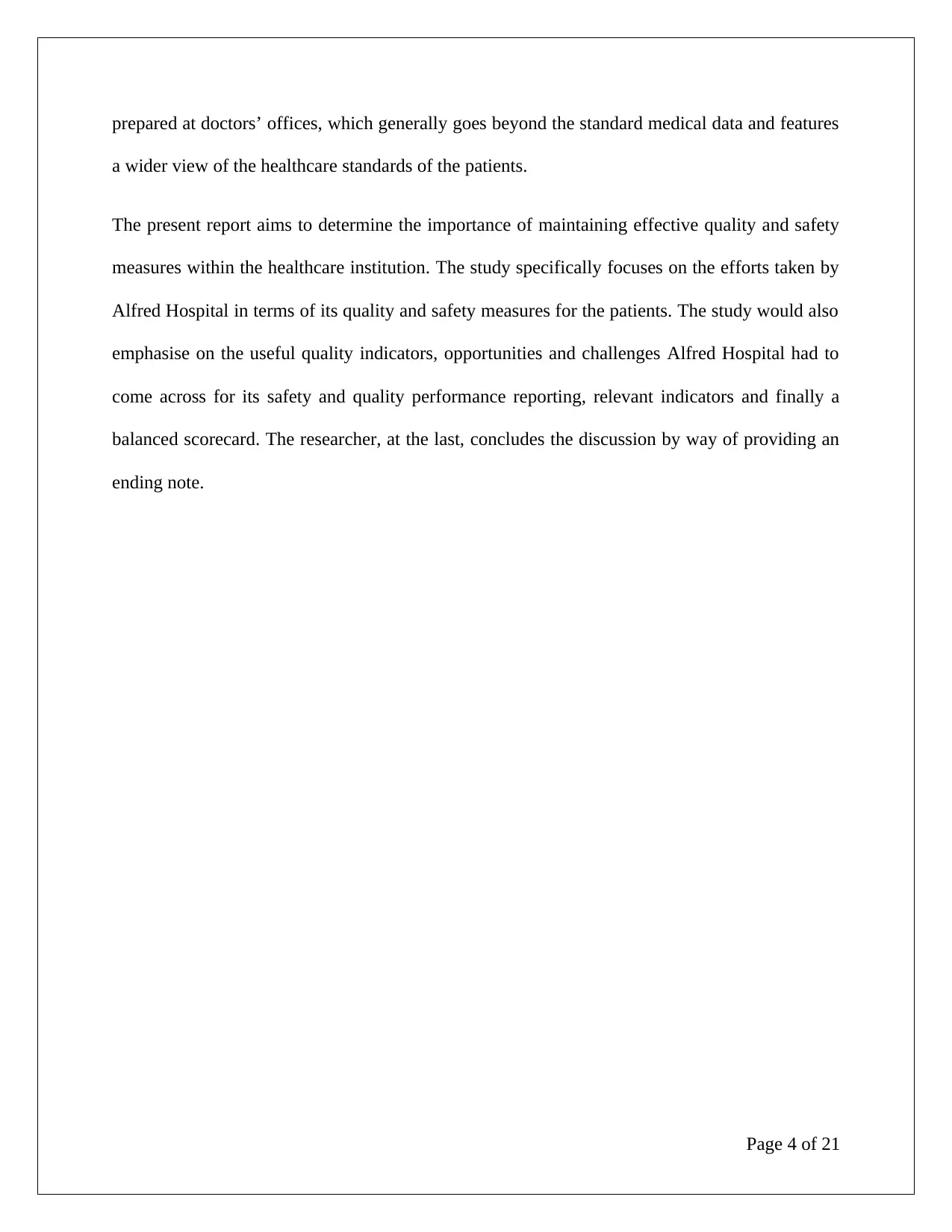
prepared at doctors’ offices, which generally goes beyond the standard medical data and features
a wider view of the healthcare standards of the patients.
The present report aims to determine the importance of maintaining effective quality and safety
measures within the healthcare institution. The study specifically focuses on the efforts taken by
Alfred Hospital in terms of its quality and safety measures for the patients. The study would also
emphasise on the useful quality indicators, opportunities and challenges Alfred Hospital had to
come across for its safety and quality performance reporting, relevant indicators and finally a
balanced scorecard. The researcher, at the last, concludes the discussion by way of providing an
ending note.
Page 4 of 21
a wider view of the healthcare standards of the patients.
The present report aims to determine the importance of maintaining effective quality and safety
measures within the healthcare institution. The study specifically focuses on the efforts taken by
Alfred Hospital in terms of its quality and safety measures for the patients. The study would also
emphasise on the useful quality indicators, opportunities and challenges Alfred Hospital had to
come across for its safety and quality performance reporting, relevant indicators and finally a
balanced scorecard. The researcher, at the last, concludes the discussion by way of providing an
ending note.
Page 4 of 21
Paraphrase This Document
Need a fresh take? Get an instant paraphrase of this document with our AI Paraphraser
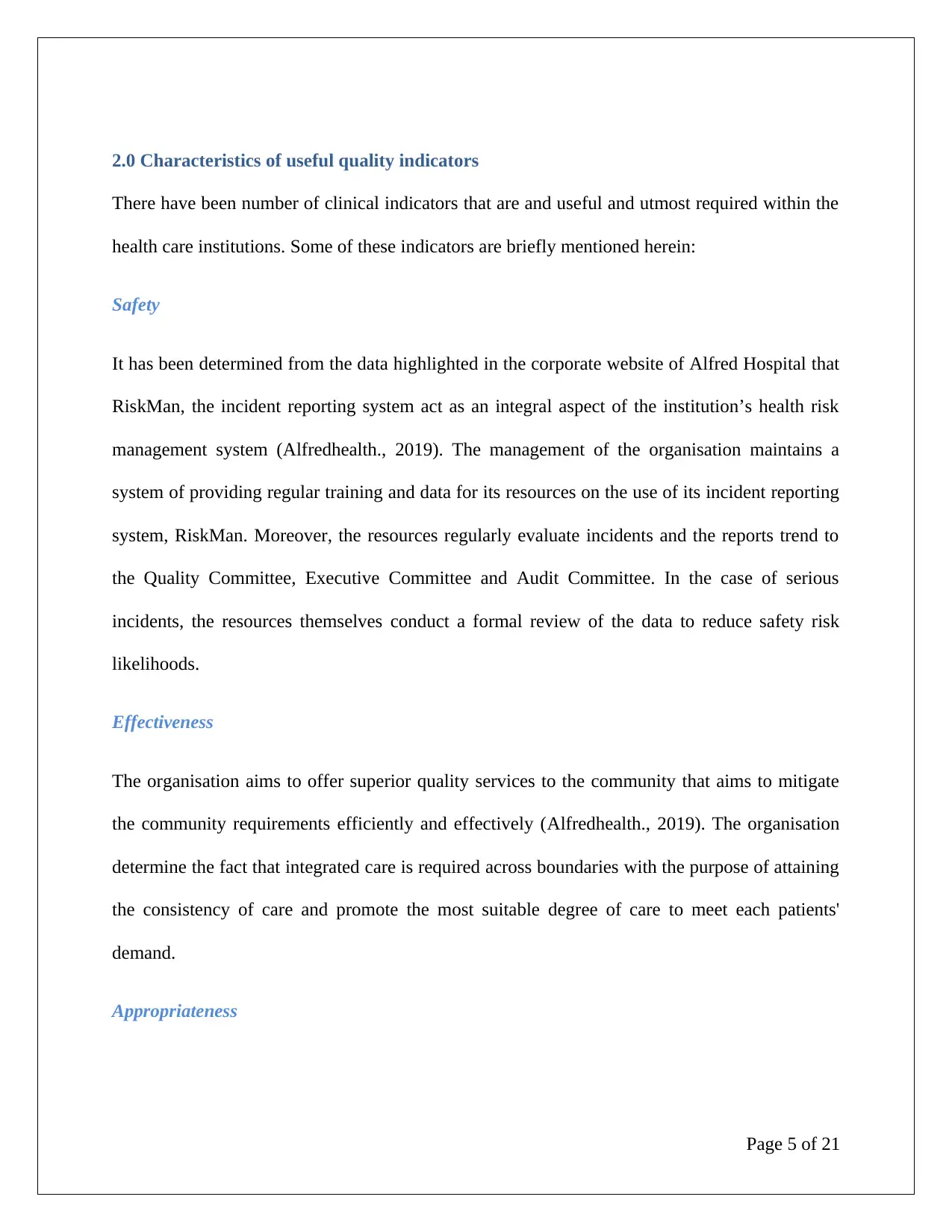
2.0 Characteristics of useful quality indicators
There have been number of clinical indicators that are and useful and utmost required within the
health care institutions. Some of these indicators are briefly mentioned herein:
Safety
It has been determined from the data highlighted in the corporate website of Alfred Hospital that
RiskMan, the incident reporting system act as an integral aspect of the institution’s health risk
management system (Alfredhealth., 2019). The management of the organisation maintains a
system of providing regular training and data for its resources on the use of its incident reporting
system, RiskMan. Moreover, the resources regularly evaluate incidents and the reports trend to
the Quality Committee, Executive Committee and Audit Committee. In the case of serious
incidents, the resources themselves conduct a formal review of the data to reduce safety risk
likelihoods.
Effectiveness
The organisation aims to offer superior quality services to the community that aims to mitigate
the community requirements efficiently and effectively (Alfredhealth., 2019). The organisation
determine the fact that integrated care is required across boundaries with the purpose of attaining
the consistency of care and promote the most suitable degree of care to meet each patients'
demand.
Appropriateness
Page 5 of 21
There have been number of clinical indicators that are and useful and utmost required within the
health care institutions. Some of these indicators are briefly mentioned herein:
Safety
It has been determined from the data highlighted in the corporate website of Alfred Hospital that
RiskMan, the incident reporting system act as an integral aspect of the institution’s health risk
management system (Alfredhealth., 2019). The management of the organisation maintains a
system of providing regular training and data for its resources on the use of its incident reporting
system, RiskMan. Moreover, the resources regularly evaluate incidents and the reports trend to
the Quality Committee, Executive Committee and Audit Committee. In the case of serious
incidents, the resources themselves conduct a formal review of the data to reduce safety risk
likelihoods.
Effectiveness
The organisation aims to offer superior quality services to the community that aims to mitigate
the community requirements efficiently and effectively (Alfredhealth., 2019). The organisation
determine the fact that integrated care is required across boundaries with the purpose of attaining
the consistency of care and promote the most suitable degree of care to meet each patients'
demand.
Appropriateness
Page 5 of 21
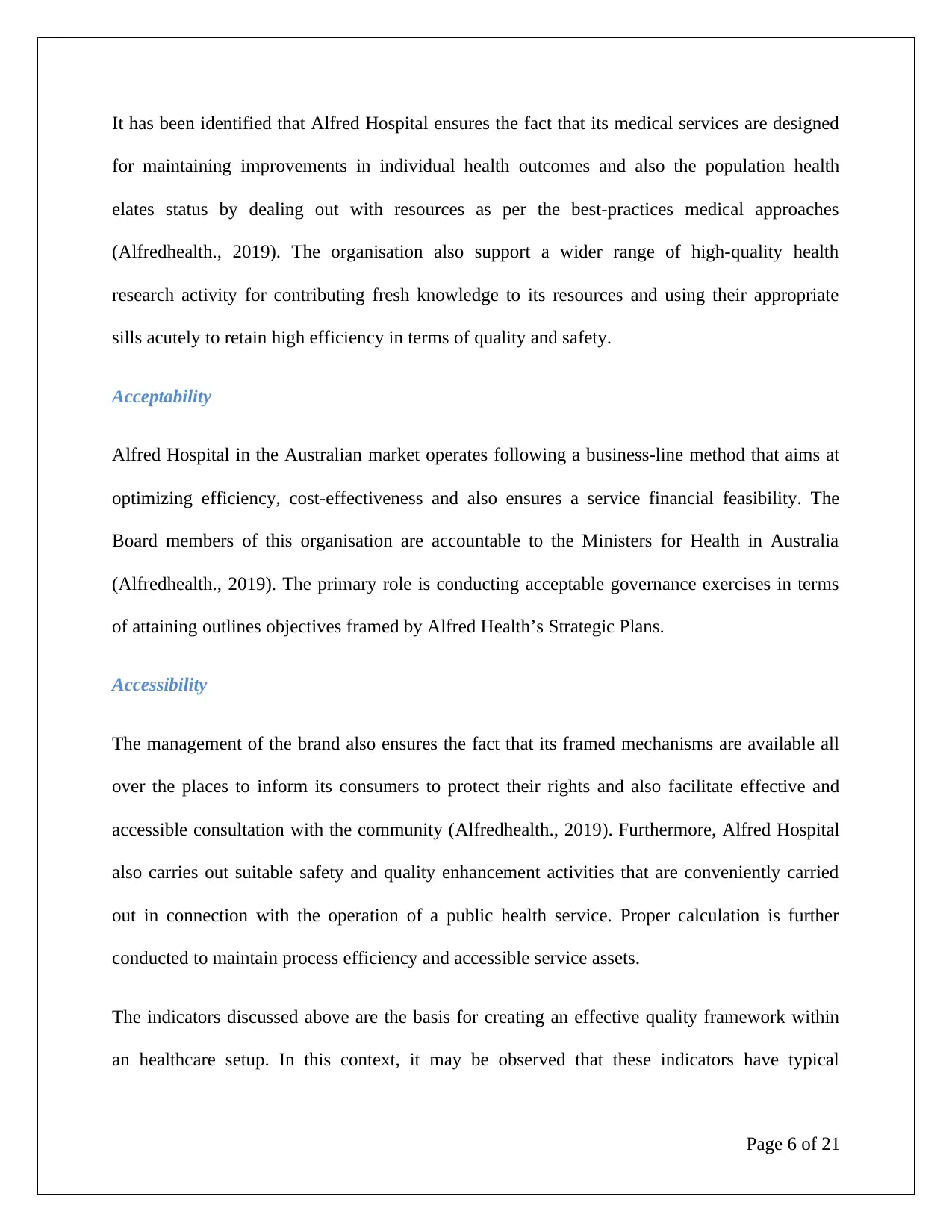
It has been identified that Alfred Hospital ensures the fact that its medical services are designed
for maintaining improvements in individual health outcomes and also the population health
elates status by dealing out with resources as per the best-practices medical approaches
(Alfredhealth., 2019). The organisation also support a wider range of high-quality health
research activity for contributing fresh knowledge to its resources and using their appropriate
sills acutely to retain high efficiency in terms of quality and safety.
Acceptability
Alfred Hospital in the Australian market operates following a business-line method that aims at
optimizing efficiency, cost-effectiveness and also ensures a service financial feasibility. The
Board members of this organisation are accountable to the Ministers for Health in Australia
(Alfredhealth., 2019). The primary role is conducting acceptable governance exercises in terms
of attaining outlines objectives framed by Alfred Health’s Strategic Plans.
Accessibility
The management of the brand also ensures the fact that its framed mechanisms are available all
over the places to inform its consumers to protect their rights and also facilitate effective and
accessible consultation with the community (Alfredhealth., 2019). Furthermore, Alfred Hospital
also carries out suitable safety and quality enhancement activities that are conveniently carried
out in connection with the operation of a public health service. Proper calculation is further
conducted to maintain process efficiency and accessible service assets.
The indicators discussed above are the basis for creating an effective quality framework within
an healthcare setup. In this context, it may be observed that these indicators have typical
Page 6 of 21
for maintaining improvements in individual health outcomes and also the population health
elates status by dealing out with resources as per the best-practices medical approaches
(Alfredhealth., 2019). The organisation also support a wider range of high-quality health
research activity for contributing fresh knowledge to its resources and using their appropriate
sills acutely to retain high efficiency in terms of quality and safety.
Acceptability
Alfred Hospital in the Australian market operates following a business-line method that aims at
optimizing efficiency, cost-effectiveness and also ensures a service financial feasibility. The
Board members of this organisation are accountable to the Ministers for Health in Australia
(Alfredhealth., 2019). The primary role is conducting acceptable governance exercises in terms
of attaining outlines objectives framed by Alfred Health’s Strategic Plans.
Accessibility
The management of the brand also ensures the fact that its framed mechanisms are available all
over the places to inform its consumers to protect their rights and also facilitate effective and
accessible consultation with the community (Alfredhealth., 2019). Furthermore, Alfred Hospital
also carries out suitable safety and quality enhancement activities that are conveniently carried
out in connection with the operation of a public health service. Proper calculation is further
conducted to maintain process efficiency and accessible service assets.
The indicators discussed above are the basis for creating an effective quality framework within
an healthcare setup. In this context, it may be observed that these indicators have typical
Page 6 of 21
You're viewing a preview
Unlock full access by subscribing today!
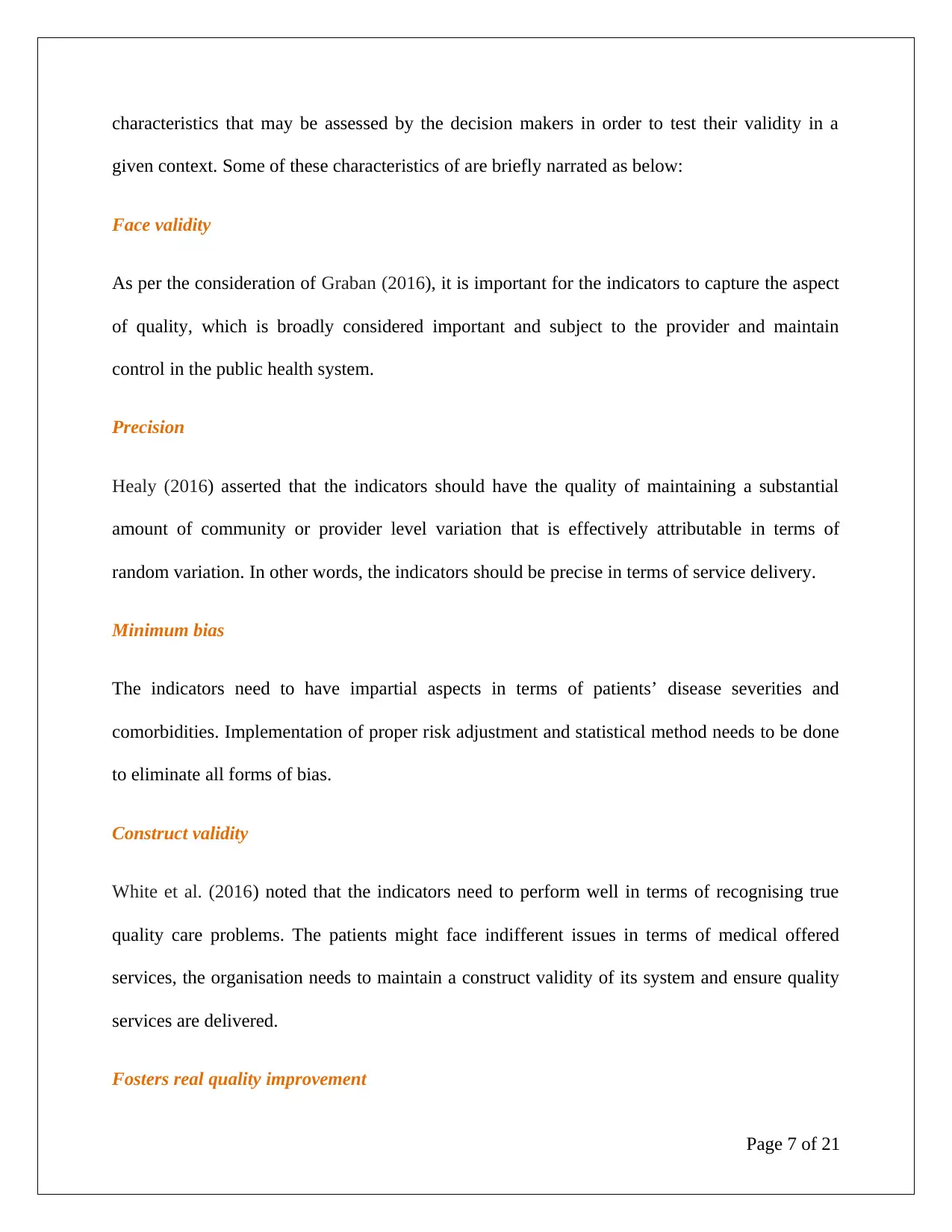
characteristics that may be assessed by the decision makers in order to test their validity in a
given context. Some of these characteristics of are briefly narrated as below:
Face validity
As per the consideration of Graban (2016), it is important for the indicators to capture the aspect
of quality, which is broadly considered important and subject to the provider and maintain
control in the public health system.
Precision
Healy (2016) asserted that the indicators should have the quality of maintaining a substantial
amount of community or provider level variation that is effectively attributable in terms of
random variation. In other words, the indicators should be precise in terms of service delivery.
Minimum bias
The indicators need to have impartial aspects in terms of patients’ disease severities and
comorbidities. Implementation of proper risk adjustment and statistical method needs to be done
to eliminate all forms of bias.
Construct validity
White et al. (2016) noted that the indicators need to perform well in terms of recognising true
quality care problems. The patients might face indifferent issues in terms of medical offered
services, the organisation needs to maintain a construct validity of its system and ensure quality
services are delivered.
Fosters real quality improvement
Page 7 of 21
given context. Some of these characteristics of are briefly narrated as below:
Face validity
As per the consideration of Graban (2016), it is important for the indicators to capture the aspect
of quality, which is broadly considered important and subject to the provider and maintain
control in the public health system.
Precision
Healy (2016) asserted that the indicators should have the quality of maintaining a substantial
amount of community or provider level variation that is effectively attributable in terms of
random variation. In other words, the indicators should be precise in terms of service delivery.
Minimum bias
The indicators need to have impartial aspects in terms of patients’ disease severities and
comorbidities. Implementation of proper risk adjustment and statistical method needs to be done
to eliminate all forms of bias.
Construct validity
White et al. (2016) noted that the indicators need to perform well in terms of recognising true
quality care problems. The patients might face indifferent issues in terms of medical offered
services, the organisation needs to maintain a construct validity of its system and ensure quality
services are delivered.
Fosters real quality improvement
Page 7 of 21
Paraphrase This Document
Need a fresh take? Get an instant paraphrase of this document with our AI Paraphraser
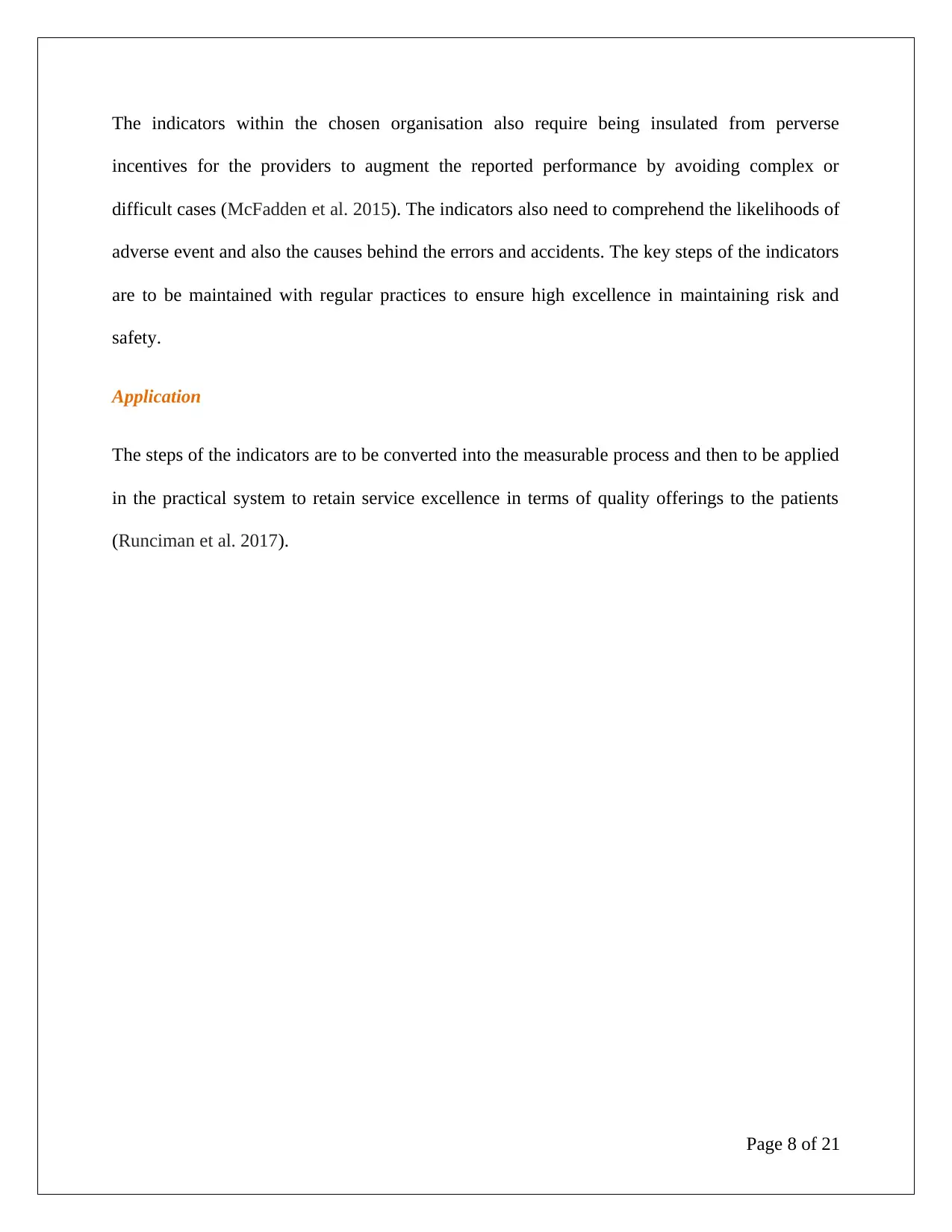
The indicators within the chosen organisation also require being insulated from perverse
incentives for the providers to augment the reported performance by avoiding complex or
difficult cases (McFadden et al. 2015). The indicators also need to comprehend the likelihoods of
adverse event and also the causes behind the errors and accidents. The key steps of the indicators
are to be maintained with regular practices to ensure high excellence in maintaining risk and
safety.
Application
The steps of the indicators are to be converted into the measurable process and then to be applied
in the practical system to retain service excellence in terms of quality offerings to the patients
(Runciman et al. 2017).
Page 8 of 21
incentives for the providers to augment the reported performance by avoiding complex or
difficult cases (McFadden et al. 2015). The indicators also need to comprehend the likelihoods of
adverse event and also the causes behind the errors and accidents. The key steps of the indicators
are to be maintained with regular practices to ensure high excellence in maintaining risk and
safety.
Application
The steps of the indicators are to be converted into the measurable process and then to be applied
in the practical system to retain service excellence in terms of quality offerings to the patients
(Runciman et al. 2017).
Page 8 of 21

3.0 Opportunities and challenges for safety and quality performance reporting
The opportunities are detailed below:
Improvement in the coding practices
With effective coding practice, the chosen hospital would get an adequate scope of reducing and
controlling its operating costs. Dixon-Woods & Martin (2016) stated that it has become one of
the concerns regarding the confused patient getting trapped between the payer and the provider,
having major doubts regarding the treatment, diagnosis and billing. Therefore, Current
Procedural Terminology codes are considered as a uniform code, which is generally used in
describing the quality medical, diagnostic and surgical services provided by this healthcare
provider (Ball et al. 2015).
Improvement in data availability
For having a fast and appropriate medical coding system to get data available information,
Alfred Hospital would require an expert team of AAPC (American Academy of
Professional Coders), the most certified medical coders those carry an in-depth comprehension
throughout health-related expertise and compliance requirements. Singh et al. (2016) argued that
having an in-house team of effective coding professionals might be sturdy, which might not
result in a high ROI. However, on the other side, the hospital system would get more efficient in
terms of handling more data and maintaining corrective accuracy, based on which the quality
service lines are to be designed for maintaining patient safety (Carthon et al. 2019).
Quality feasible screening
Page 9 of 21
The opportunities are detailed below:
Improvement in the coding practices
With effective coding practice, the chosen hospital would get an adequate scope of reducing and
controlling its operating costs. Dixon-Woods & Martin (2016) stated that it has become one of
the concerns regarding the confused patient getting trapped between the payer and the provider,
having major doubts regarding the treatment, diagnosis and billing. Therefore, Current
Procedural Terminology codes are considered as a uniform code, which is generally used in
describing the quality medical, diagnostic and surgical services provided by this healthcare
provider (Ball et al. 2015).
Improvement in data availability
For having a fast and appropriate medical coding system to get data available information,
Alfred Hospital would require an expert team of AAPC (American Academy of
Professional Coders), the most certified medical coders those carry an in-depth comprehension
throughout health-related expertise and compliance requirements. Singh et al. (2016) argued that
having an in-house team of effective coding professionals might be sturdy, which might not
result in a high ROI. However, on the other side, the hospital system would get more efficient in
terms of handling more data and maintaining corrective accuracy, based on which the quality
service lines are to be designed for maintaining patient safety (Carthon et al. 2019).
Quality feasible screening
Page 9 of 21
You're viewing a preview
Unlock full access by subscribing today!
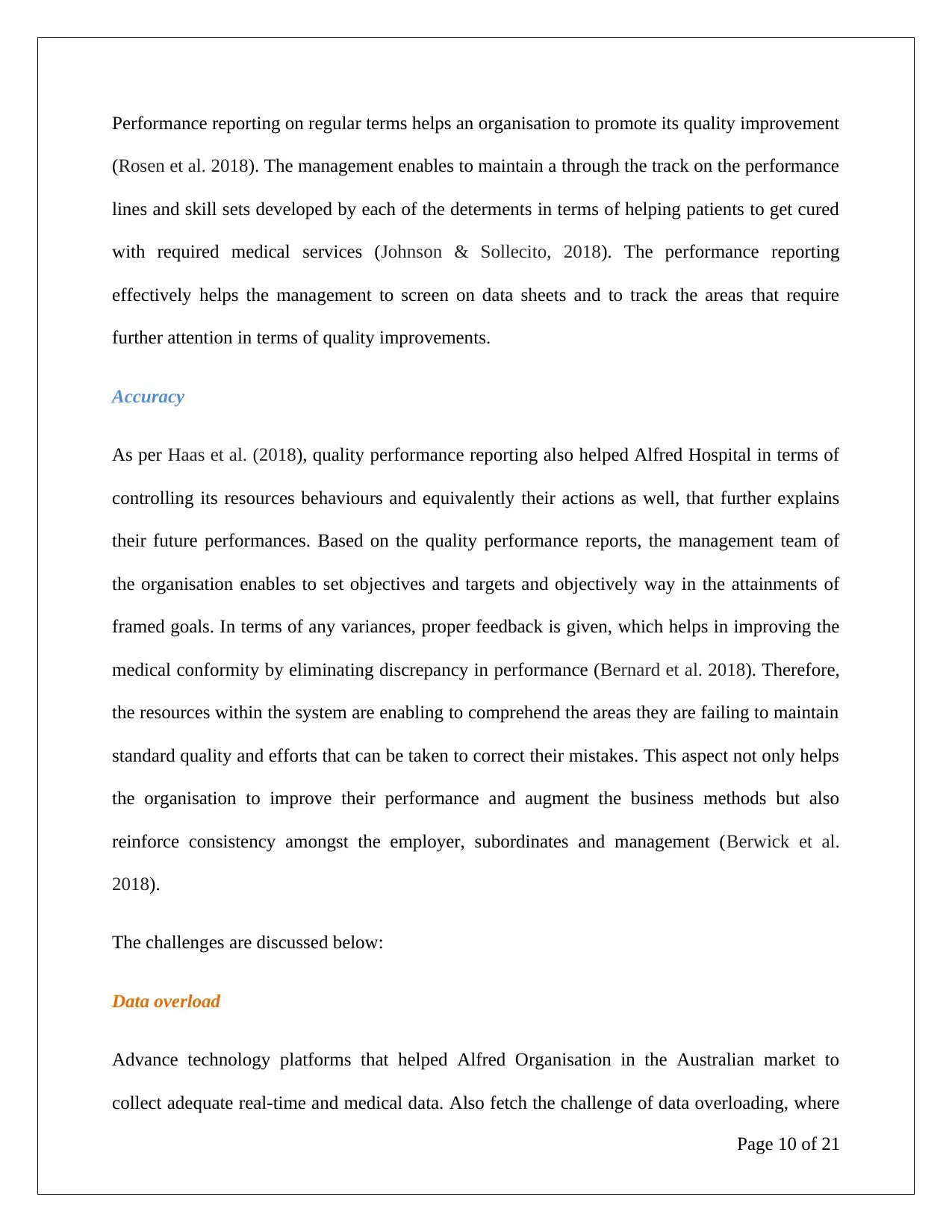
Performance reporting on regular terms helps an organisation to promote its quality improvement
(Rosen et al. 2018). The management enables to maintain a through the track on the performance
lines and skill sets developed by each of the determents in terms of helping patients to get cured
with required medical services (Johnson & Sollecito, 2018). The performance reporting
effectively helps the management to screen on data sheets and to track the areas that require
further attention in terms of quality improvements.
Accuracy
As per Haas et al. (2018), quality performance reporting also helped Alfred Hospital in terms of
controlling its resources behaviours and equivalently their actions as well, that further explains
their future performances. Based on the quality performance reports, the management team of
the organisation enables to set objectives and targets and objectively way in the attainments of
framed goals. In terms of any variances, proper feedback is given, which helps in improving the
medical conformity by eliminating discrepancy in performance (Bernard et al. 2018). Therefore,
the resources within the system are enabling to comprehend the areas they are failing to maintain
standard quality and efforts that can be taken to correct their mistakes. This aspect not only helps
the organisation to improve their performance and augment the business methods but also
reinforce consistency amongst the employer, subordinates and management (Berwick et al.
2018).
The challenges are discussed below:
Data overload
Advance technology platforms that helped Alfred Organisation in the Australian market to
collect adequate real-time and medical data. Also fetch the challenge of data overloading, where
Page 10 of 21
(Rosen et al. 2018). The management enables to maintain a through the track on the performance
lines and skill sets developed by each of the determents in terms of helping patients to get cured
with required medical services (Johnson & Sollecito, 2018). The performance reporting
effectively helps the management to screen on data sheets and to track the areas that require
further attention in terms of quality improvements.
Accuracy
As per Haas et al. (2018), quality performance reporting also helped Alfred Hospital in terms of
controlling its resources behaviours and equivalently their actions as well, that further explains
their future performances. Based on the quality performance reports, the management team of
the organisation enables to set objectives and targets and objectively way in the attainments of
framed goals. In terms of any variances, proper feedback is given, which helps in improving the
medical conformity by eliminating discrepancy in performance (Bernard et al. 2018). Therefore,
the resources within the system are enabling to comprehend the areas they are failing to maintain
standard quality and efforts that can be taken to correct their mistakes. This aspect not only helps
the organisation to improve their performance and augment the business methods but also
reinforce consistency amongst the employer, subordinates and management (Berwick et al.
2018).
The challenges are discussed below:
Data overload
Advance technology platforms that helped Alfred Organisation in the Australian market to
collect adequate real-time and medical data. Also fetch the challenge of data overloading, where
Page 10 of 21
Paraphrase This Document
Need a fresh take? Get an instant paraphrase of this document with our AI Paraphraser
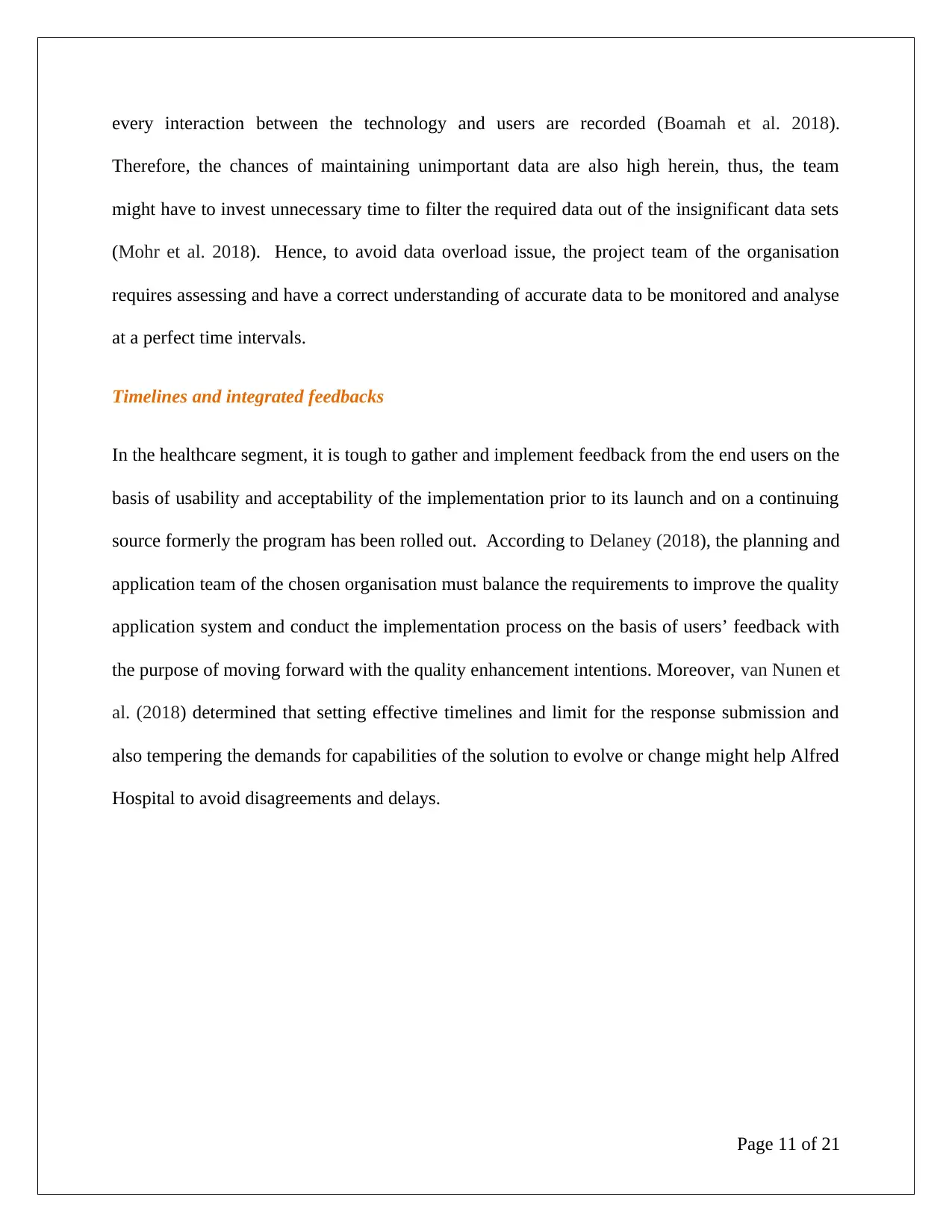
every interaction between the technology and users are recorded (Boamah et al. 2018).
Therefore, the chances of maintaining unimportant data are also high herein, thus, the team
might have to invest unnecessary time to filter the required data out of the insignificant data sets
(Mohr et al. 2018). Hence, to avoid data overload issue, the project team of the organisation
requires assessing and have a correct understanding of accurate data to be monitored and analyse
at a perfect time intervals.
Timelines and integrated feedbacks
In the healthcare segment, it is tough to gather and implement feedback from the end users on the
basis of usability and acceptability of the implementation prior to its launch and on a continuing
source formerly the program has been rolled out. According to Delaney (2018), the planning and
application team of the chosen organisation must balance the requirements to improve the quality
application system and conduct the implementation process on the basis of users’ feedback with
the purpose of moving forward with the quality enhancement intentions. Moreover, van Nunen et
al. (2018) determined that setting effective timelines and limit for the response submission and
also tempering the demands for capabilities of the solution to evolve or change might help Alfred
Hospital to avoid disagreements and delays.
Page 11 of 21
Therefore, the chances of maintaining unimportant data are also high herein, thus, the team
might have to invest unnecessary time to filter the required data out of the insignificant data sets
(Mohr et al. 2018). Hence, to avoid data overload issue, the project team of the organisation
requires assessing and have a correct understanding of accurate data to be monitored and analyse
at a perfect time intervals.
Timelines and integrated feedbacks
In the healthcare segment, it is tough to gather and implement feedback from the end users on the
basis of usability and acceptability of the implementation prior to its launch and on a continuing
source formerly the program has been rolled out. According to Delaney (2018), the planning and
application team of the chosen organisation must balance the requirements to improve the quality
application system and conduct the implementation process on the basis of users’ feedback with
the purpose of moving forward with the quality enhancement intentions. Moreover, van Nunen et
al. (2018) determined that setting effective timelines and limit for the response submission and
also tempering the demands for capabilities of the solution to evolve or change might help Alfred
Hospital to avoid disagreements and delays.
Page 11 of 21
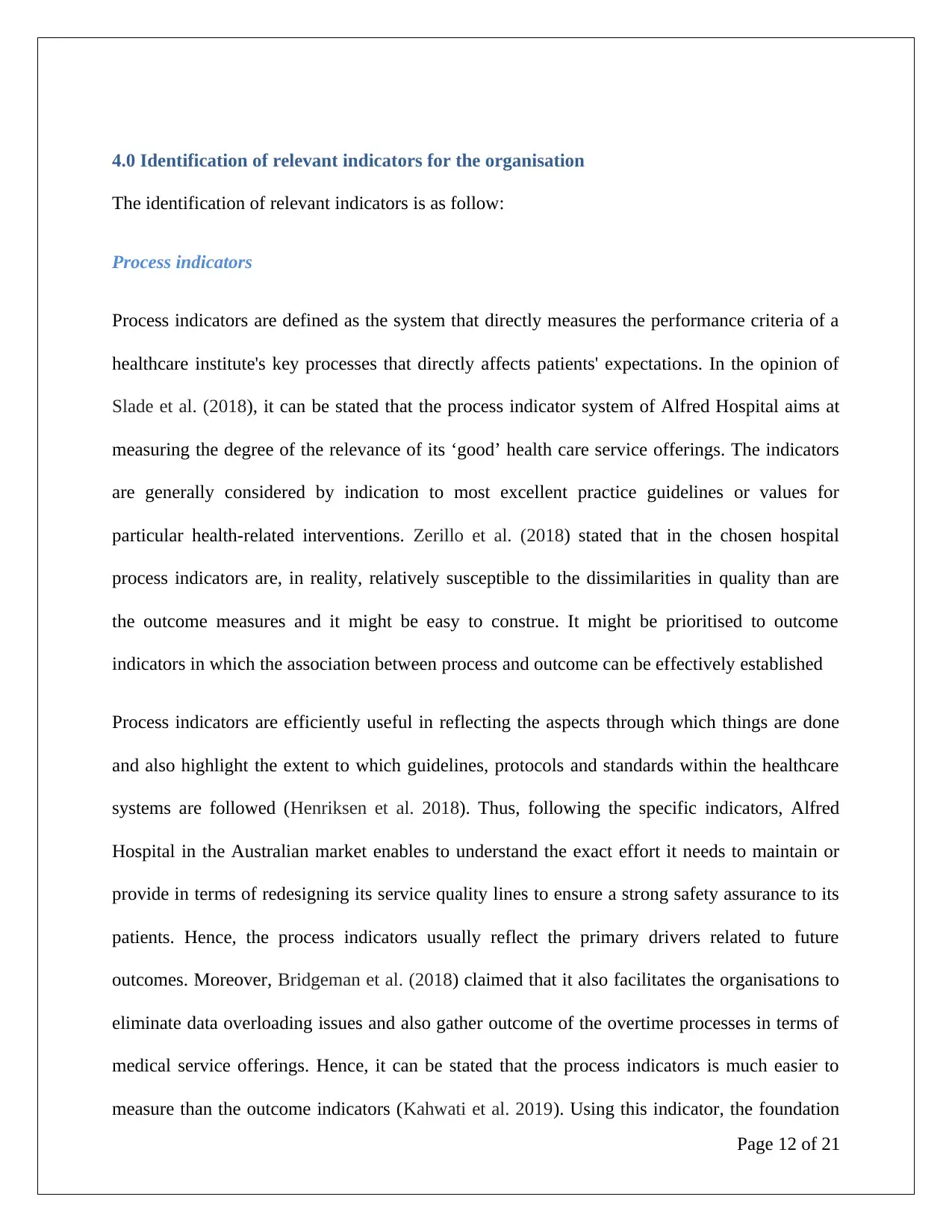
4.0 Identification of relevant indicators for the organisation
The identification of relevant indicators is as follow:
Process indicators
Process indicators are defined as the system that directly measures the performance criteria of a
healthcare institute's key processes that directly affects patients' expectations. In the opinion of
Slade et al. (2018), it can be stated that the process indicator system of Alfred Hospital aims at
measuring the degree of the relevance of its ‘good’ health care service offerings. The indicators
are generally considered by indication to most excellent practice guidelines or values for
particular health-related interventions. Zerillo et al. (2018) stated that in the chosen hospital
process indicators are, in reality, relatively susceptible to the dissimilarities in quality than are
the outcome measures and it might be easy to construe. It might be prioritised to outcome
indicators in which the association between process and outcome can be effectively established
Process indicators are efficiently useful in reflecting the aspects through which things are done
and also highlight the extent to which guidelines, protocols and standards within the healthcare
systems are followed (Henriksen et al. 2018). Thus, following the specific indicators, Alfred
Hospital in the Australian market enables to understand the exact effort it needs to maintain or
provide in terms of redesigning its service quality lines to ensure a strong safety assurance to its
patients. Hence, the process indicators usually reflect the primary drivers related to future
outcomes. Moreover, Bridgeman et al. (2018) claimed that it also facilitates the organisations to
eliminate data overloading issues and also gather outcome of the overtime processes in terms of
medical service offerings. Hence, it can be stated that the process indicators is much easier to
measure than the outcome indicators (Kahwati et al. 2019). Using this indicator, the foundation
Page 12 of 21
The identification of relevant indicators is as follow:
Process indicators
Process indicators are defined as the system that directly measures the performance criteria of a
healthcare institute's key processes that directly affects patients' expectations. In the opinion of
Slade et al. (2018), it can be stated that the process indicator system of Alfred Hospital aims at
measuring the degree of the relevance of its ‘good’ health care service offerings. The indicators
are generally considered by indication to most excellent practice guidelines or values for
particular health-related interventions. Zerillo et al. (2018) stated that in the chosen hospital
process indicators are, in reality, relatively susceptible to the dissimilarities in quality than are
the outcome measures and it might be easy to construe. It might be prioritised to outcome
indicators in which the association between process and outcome can be effectively established
Process indicators are efficiently useful in reflecting the aspects through which things are done
and also highlight the extent to which guidelines, protocols and standards within the healthcare
systems are followed (Henriksen et al. 2018). Thus, following the specific indicators, Alfred
Hospital in the Australian market enables to understand the exact effort it needs to maintain or
provide in terms of redesigning its service quality lines to ensure a strong safety assurance to its
patients. Hence, the process indicators usually reflect the primary drivers related to future
outcomes. Moreover, Bridgeman et al. (2018) claimed that it also facilitates the organisations to
eliminate data overloading issues and also gather outcome of the overtime processes in terms of
medical service offerings. Hence, it can be stated that the process indicators is much easier to
measure than the outcome indicators (Kahwati et al. 2019). Using this indicator, the foundation
Page 12 of 21
You're viewing a preview
Unlock full access by subscribing today!
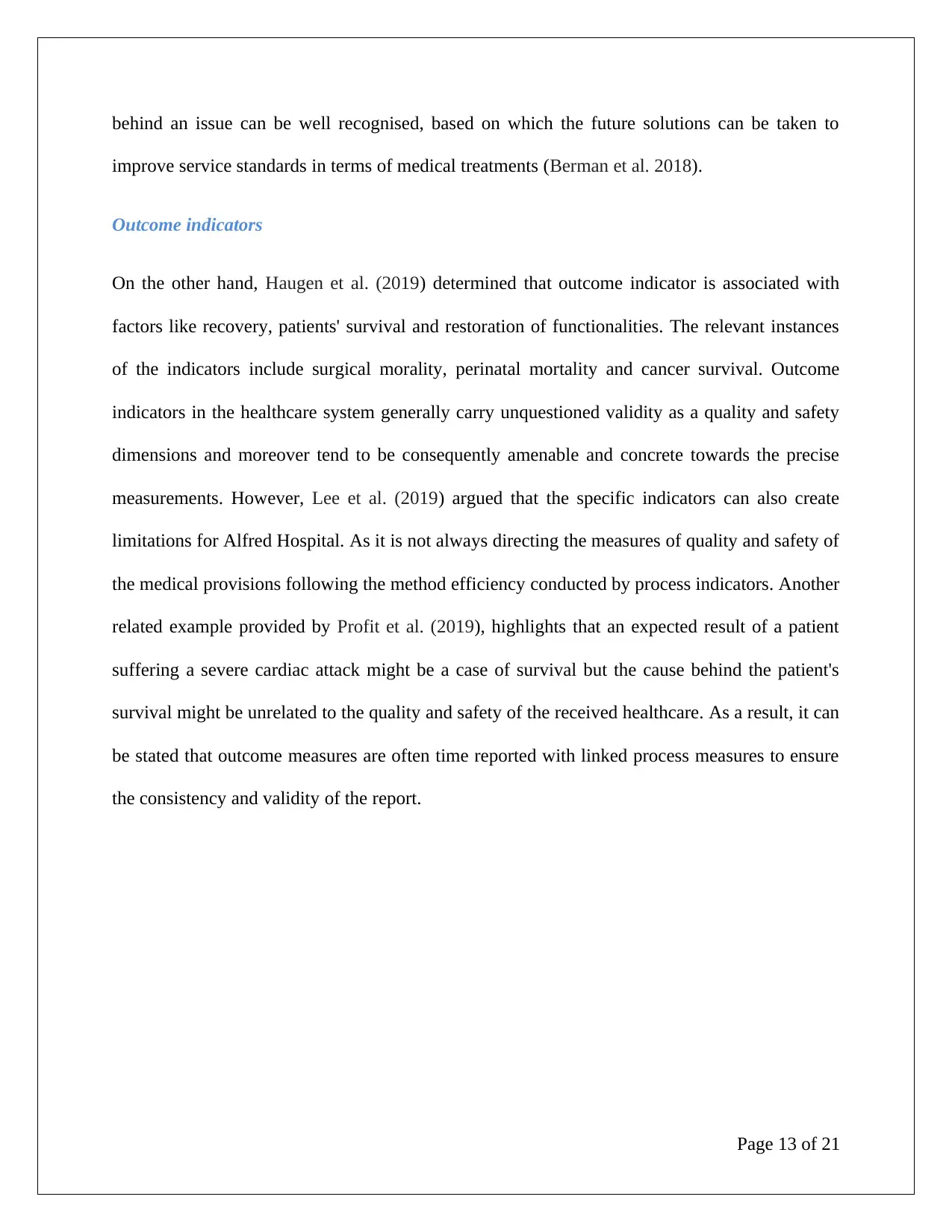
behind an issue can be well recognised, based on which the future solutions can be taken to
improve service standards in terms of medical treatments (Berman et al. 2018).
Outcome indicators
On the other hand, Haugen et al. (2019) determined that outcome indicator is associated with
factors like recovery, patients' survival and restoration of functionalities. The relevant instances
of the indicators include surgical morality, perinatal mortality and cancer survival. Outcome
indicators in the healthcare system generally carry unquestioned validity as a quality and safety
dimensions and moreover tend to be consequently amenable and concrete towards the precise
measurements. However, Lee et al. (2019) argued that the specific indicators can also create
limitations for Alfred Hospital. As it is not always directing the measures of quality and safety of
the medical provisions following the method efficiency conducted by process indicators. Another
related example provided by Profit et al. (2019), highlights that an expected result of a patient
suffering a severe cardiac attack might be a case of survival but the cause behind the patient's
survival might be unrelated to the quality and safety of the received healthcare. As a result, it can
be stated that outcome measures are often time reported with linked process measures to ensure
the consistency and validity of the report.
Page 13 of 21
improve service standards in terms of medical treatments (Berman et al. 2018).
Outcome indicators
On the other hand, Haugen et al. (2019) determined that outcome indicator is associated with
factors like recovery, patients' survival and restoration of functionalities. The relevant instances
of the indicators include surgical morality, perinatal mortality and cancer survival. Outcome
indicators in the healthcare system generally carry unquestioned validity as a quality and safety
dimensions and moreover tend to be consequently amenable and concrete towards the precise
measurements. However, Lee et al. (2019) argued that the specific indicators can also create
limitations for Alfred Hospital. As it is not always directing the measures of quality and safety of
the medical provisions following the method efficiency conducted by process indicators. Another
related example provided by Profit et al. (2019), highlights that an expected result of a patient
suffering a severe cardiac attack might be a case of survival but the cause behind the patient's
survival might be unrelated to the quality and safety of the received healthcare. As a result, it can
be stated that outcome measures are often time reported with linked process measures to ensure
the consistency and validity of the report.
Page 13 of 21
Paraphrase This Document
Need a fresh take? Get an instant paraphrase of this document with our AI Paraphraser
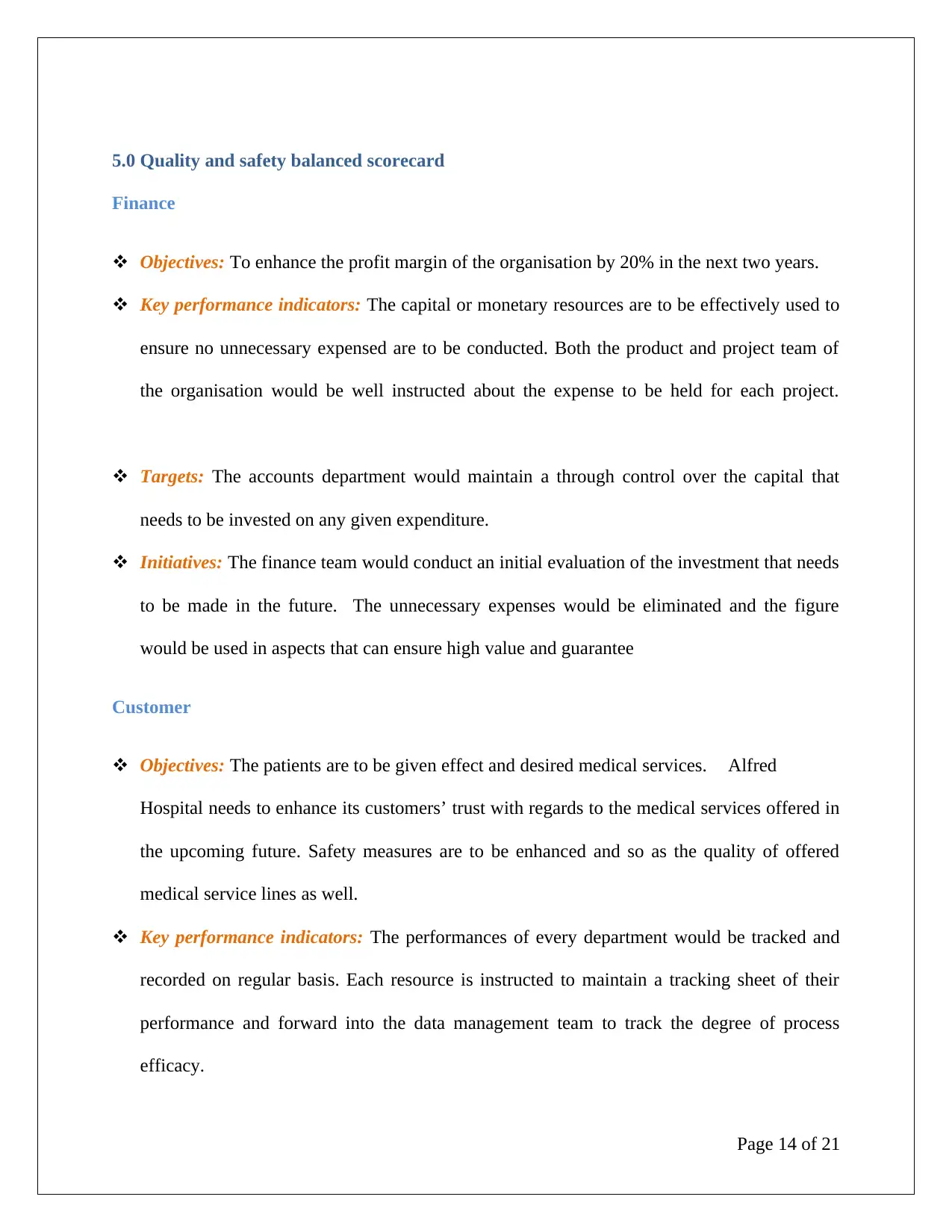
5.0 Quality and safety balanced scorecard
Finance
Objectives: To enhance the profit margin of the organisation by 20% in the next two years.
Key performance indicators: The capital or monetary resources are to be effectively used to
ensure no unnecessary expensed are to be conducted. Both the product and project team of
the organisation would be well instructed about the expense to be held for each project.
Targets: The accounts department would maintain a through control over the capital that
needs to be invested on any given expenditure.
Initiatives: The finance team would conduct an initial evaluation of the investment that needs
to be made in the future. The unnecessary expenses would be eliminated and the figure
would be used in aspects that can ensure high value and guarantee
Customer
Objectives: The patients are to be given effect and desired medical services. Alfred
Hospital needs to enhance its customers’ trust with regards to the medical services offered in
the upcoming future. Safety measures are to be enhanced and so as the quality of offered
medical service lines as well.
Key performance indicators: The performances of every department would be tracked and
recorded on regular basis. Each resource is instructed to maintain a tracking sheet of their
performance and forward into the data management team to track the degree of process
efficacy.
Page 14 of 21
Finance
Objectives: To enhance the profit margin of the organisation by 20% in the next two years.
Key performance indicators: The capital or monetary resources are to be effectively used to
ensure no unnecessary expensed are to be conducted. Both the product and project team of
the organisation would be well instructed about the expense to be held for each project.
Targets: The accounts department would maintain a through control over the capital that
needs to be invested on any given expenditure.
Initiatives: The finance team would conduct an initial evaluation of the investment that needs
to be made in the future. The unnecessary expenses would be eliminated and the figure
would be used in aspects that can ensure high value and guarantee
Customer
Objectives: The patients are to be given effect and desired medical services. Alfred
Hospital needs to enhance its customers’ trust with regards to the medical services offered in
the upcoming future. Safety measures are to be enhanced and so as the quality of offered
medical service lines as well.
Key performance indicators: The performances of every department would be tracked and
recorded on regular basis. Each resource is instructed to maintain a tracking sheet of their
performance and forward into the data management team to track the degree of process
efficacy.
Page 14 of 21
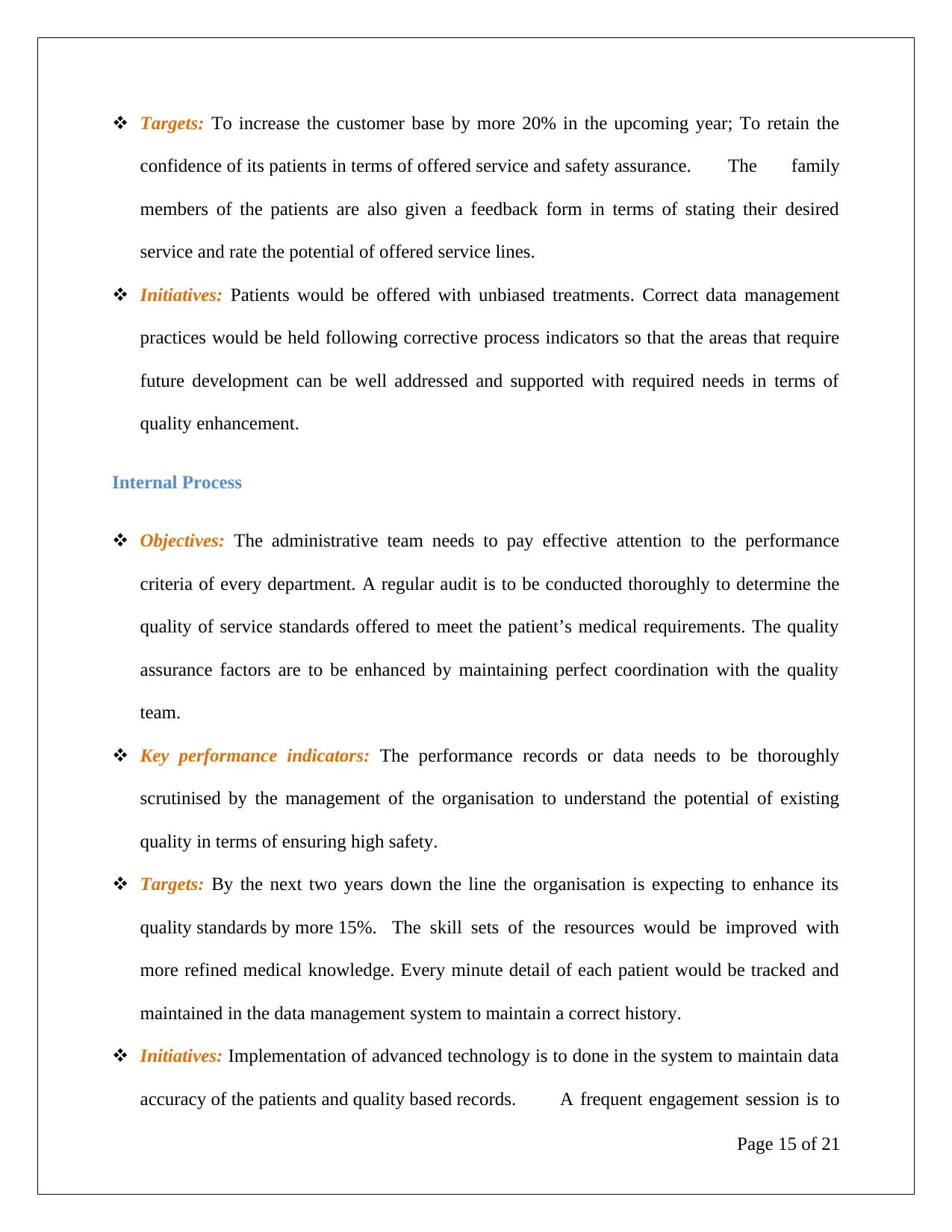
Targets: To increase the customer base by more 20% in the upcoming year; To retain the
confidence of its patients in terms of offered service and safety assurance. The family
members of the patients are also given a feedback form in terms of stating their desired
service and rate the potential of offered service lines.
Initiatives: Patients would be offered with unbiased treatments. Correct data management
practices would be held following corrective process indicators so that the areas that require
future development can be well addressed and supported with required needs in terms of
quality enhancement.
Internal Process
Objectives: The administrative team needs to pay effective attention to the performance
criteria of every department. A regular audit is to be conducted thoroughly to determine the
quality of service standards offered to meet the patient’s medical requirements. The quality
assurance factors are to be enhanced by maintaining perfect coordination with the quality
team.
Key performance indicators: The performance records or data needs to be thoroughly
scrutinised by the management of the organisation to understand the potential of existing
quality in terms of ensuring high safety.
Targets: By the next two years down the line the organisation is expecting to enhance its
quality standards by more 15%. The skill sets of the resources would be improved with
more refined medical knowledge. Every minute detail of each patient would be tracked and
maintained in the data management system to maintain a correct history.
Initiatives: Implementation of advanced technology is to done in the system to maintain data
accuracy of the patients and quality based records. A frequent engagement session is to
Page 15 of 21
confidence of its patients in terms of offered service and safety assurance. The family
members of the patients are also given a feedback form in terms of stating their desired
service and rate the potential of offered service lines.
Initiatives: Patients would be offered with unbiased treatments. Correct data management
practices would be held following corrective process indicators so that the areas that require
future development can be well addressed and supported with required needs in terms of
quality enhancement.
Internal Process
Objectives: The administrative team needs to pay effective attention to the performance
criteria of every department. A regular audit is to be conducted thoroughly to determine the
quality of service standards offered to meet the patient’s medical requirements. The quality
assurance factors are to be enhanced by maintaining perfect coordination with the quality
team.
Key performance indicators: The performance records or data needs to be thoroughly
scrutinised by the management of the organisation to understand the potential of existing
quality in terms of ensuring high safety.
Targets: By the next two years down the line the organisation is expecting to enhance its
quality standards by more 15%. The skill sets of the resources would be improved with
more refined medical knowledge. Every minute detail of each patient would be tracked and
maintained in the data management system to maintain a correct history.
Initiatives: Implementation of advanced technology is to done in the system to maintain data
accuracy of the patients and quality based records. A frequent engagement session is to
Page 15 of 21
You're viewing a preview
Unlock full access by subscribing today!
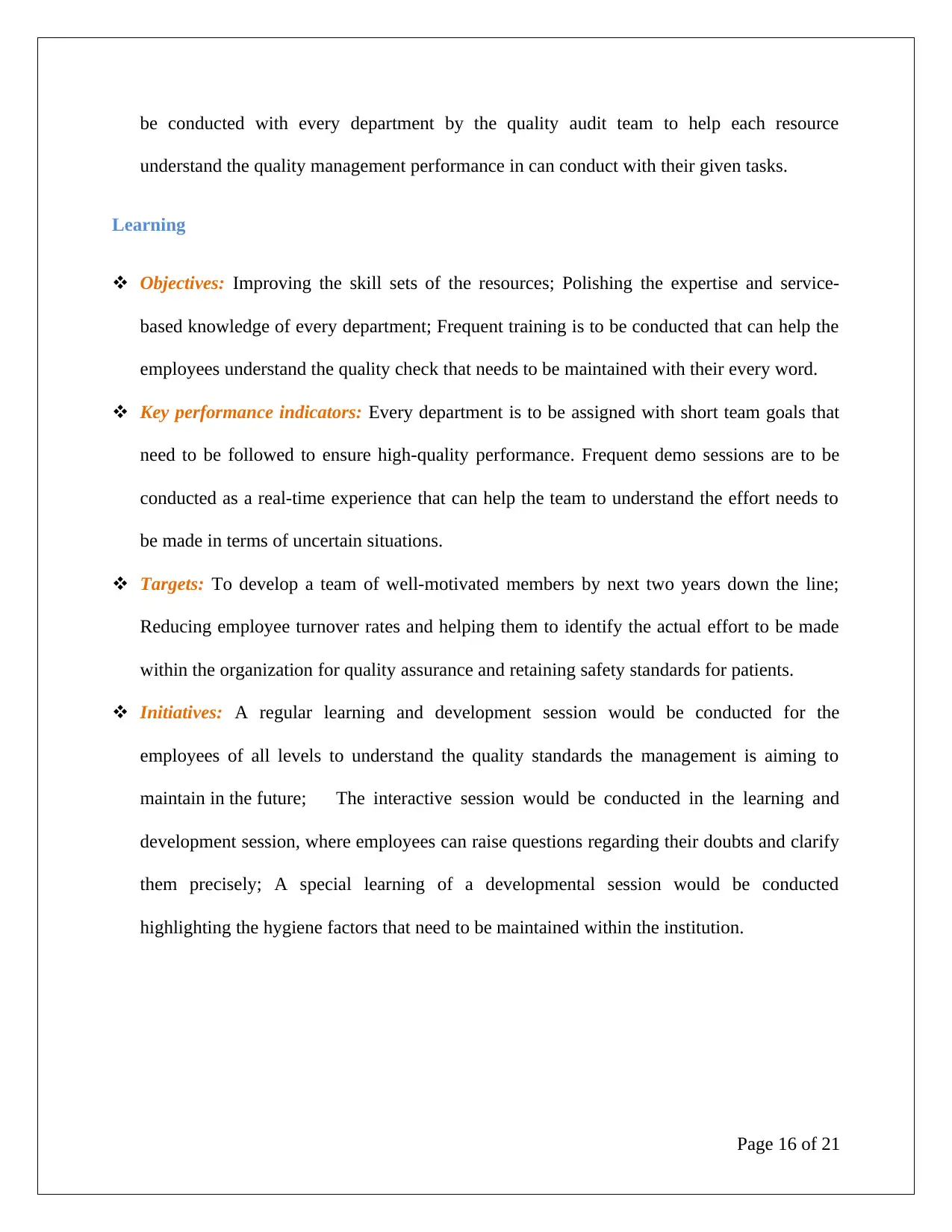
be conducted with every department by the quality audit team to help each resource
understand the quality management performance in can conduct with their given tasks.
Learning
Objectives: Improving the skill sets of the resources; Polishing the expertise and service-
based knowledge of every department; Frequent training is to be conducted that can help the
employees understand the quality check that needs to be maintained with their every word.
Key performance indicators: Every department is to be assigned with short team goals that
need to be followed to ensure high-quality performance. Frequent demo sessions are to be
conducted as a real-time experience that can help the team to understand the effort needs to
be made in terms of uncertain situations.
Targets: To develop a team of well-motivated members by next two years down the line;
Reducing employee turnover rates and helping them to identify the actual effort to be made
within the organization for quality assurance and retaining safety standards for patients.
Initiatives: A regular learning and development session would be conducted for the
employees of all levels to understand the quality standards the management is aiming to
maintain in the future; The interactive session would be conducted in the learning and
development session, where employees can raise questions regarding their doubts and clarify
them precisely; A special learning of a developmental session would be conducted
highlighting the hygiene factors that need to be maintained within the institution.
Page 16 of 21
understand the quality management performance in can conduct with their given tasks.
Learning
Objectives: Improving the skill sets of the resources; Polishing the expertise and service-
based knowledge of every department; Frequent training is to be conducted that can help the
employees understand the quality check that needs to be maintained with their every word.
Key performance indicators: Every department is to be assigned with short team goals that
need to be followed to ensure high-quality performance. Frequent demo sessions are to be
conducted as a real-time experience that can help the team to understand the effort needs to
be made in terms of uncertain situations.
Targets: To develop a team of well-motivated members by next two years down the line;
Reducing employee turnover rates and helping them to identify the actual effort to be made
within the organization for quality assurance and retaining safety standards for patients.
Initiatives: A regular learning and development session would be conducted for the
employees of all levels to understand the quality standards the management is aiming to
maintain in the future; The interactive session would be conducted in the learning and
development session, where employees can raise questions regarding their doubts and clarify
them precisely; A special learning of a developmental session would be conducted
highlighting the hygiene factors that need to be maintained within the institution.
Page 16 of 21
Paraphrase This Document
Need a fresh take? Get an instant paraphrase of this document with our AI Paraphraser

6.0 Conclusion
Based on the discussion and analysis performed in the preceding sections of the report, it may be
considered that the researcher has arrived at a concluding statement that underscores the fact that
quality and safety maintenance in every healthcare institution has become the most integral part
to fit future survival. The above discussions also highlight the fact that with the passage of time,
patients are getting more conscious about the service standards maintained by healthcare
institutes and prioritise investing their finance on institutes that ensure high quality and safety
assurance. Similar had been the case with Alfred Hospital in the Australian market, where the
management of the brand had to emphasis explicitly on the quality standards through which the
safety assurance of patients are well maintained and improved. The balanced scorecard defined
in the above statement well underscores the aspects in terms of financial, customer, internal
process and the learning and developmental efforts the organisation needs to consider in the
future ensuring its operation consistency. The organisation needs to focus on process indicators
than outcome indicators to well identify the areas or efforts that need to be maintained in the
future time to provide standard quality service assurance to its patients alongside safety
standards. Finally, it may be concluded that a well-designed quality and safety benchmark policy
coupled with the strong management and control environment will significantly contribute
towards the attainment of organisational goal of sustainability in the long-run in most optimum
and cost and time efficient manner.
Page 17 of 21
Based on the discussion and analysis performed in the preceding sections of the report, it may be
considered that the researcher has arrived at a concluding statement that underscores the fact that
quality and safety maintenance in every healthcare institution has become the most integral part
to fit future survival. The above discussions also highlight the fact that with the passage of time,
patients are getting more conscious about the service standards maintained by healthcare
institutes and prioritise investing their finance on institutes that ensure high quality and safety
assurance. Similar had been the case with Alfred Hospital in the Australian market, where the
management of the brand had to emphasis explicitly on the quality standards through which the
safety assurance of patients are well maintained and improved. The balanced scorecard defined
in the above statement well underscores the aspects in terms of financial, customer, internal
process and the learning and developmental efforts the organisation needs to consider in the
future ensuring its operation consistency. The organisation needs to focus on process indicators
than outcome indicators to well identify the areas or efforts that need to be maintained in the
future time to provide standard quality service assurance to its patients alongside safety
standards. Finally, it may be concluded that a well-designed quality and safety benchmark policy
coupled with the strong management and control environment will significantly contribute
towards the attainment of organisational goal of sustainability in the long-run in most optimum
and cost and time efficient manner.
Page 17 of 21
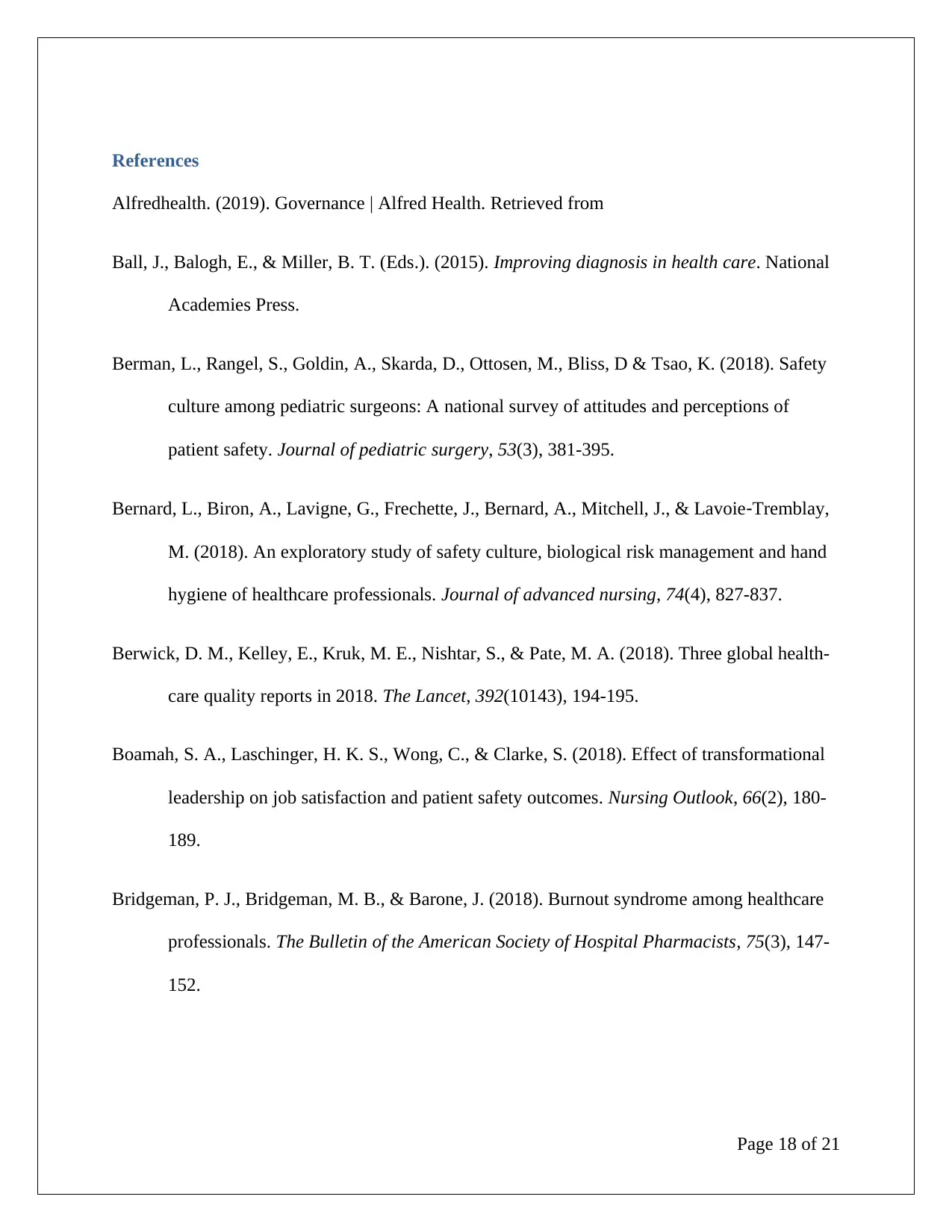
References
Alfredhealth. (2019). Governance | Alfred Health. Retrieved from
Ball, J., Balogh, E., & Miller, B. T. (Eds.). (2015). Improving diagnosis in health care. National
Academies Press.
Berman, L., Rangel, S., Goldin, A., Skarda, D., Ottosen, M., Bliss, D & Tsao, K. (2018). Safety
culture among pediatric surgeons: A national survey of attitudes and perceptions of
patient safety. Journal of pediatric surgery, 53(3), 381-395.
Bernard, L., Biron, A., Lavigne, G., Frechette, J., Bernard, A., Mitchell, J., & Lavoie‐Tremblay,
M. (2018). An exploratory study of safety culture, biological risk management and hand
hygiene of healthcare professionals. Journal of advanced nursing, 74(4), 827-837.
Berwick, D. M., Kelley, E., Kruk, M. E., Nishtar, S., & Pate, M. A. (2018). Three global health-
care quality reports in 2018. The Lancet, 392(10143), 194-195.
Boamah, S. A., Laschinger, H. K. S., Wong, C., & Clarke, S. (2018). Effect of transformational
leadership on job satisfaction and patient safety outcomes. Nursing Outlook, 66(2), 180-
189.
Bridgeman, P. J., Bridgeman, M. B., & Barone, J. (2018). Burnout syndrome among healthcare
professionals. The Bulletin of the American Society of Hospital Pharmacists, 75(3), 147-
152.
Page 18 of 21
Alfredhealth. (2019). Governance | Alfred Health. Retrieved from
Ball, J., Balogh, E., & Miller, B. T. (Eds.). (2015). Improving diagnosis in health care. National
Academies Press.
Berman, L., Rangel, S., Goldin, A., Skarda, D., Ottosen, M., Bliss, D & Tsao, K. (2018). Safety
culture among pediatric surgeons: A national survey of attitudes and perceptions of
patient safety. Journal of pediatric surgery, 53(3), 381-395.
Bernard, L., Biron, A., Lavigne, G., Frechette, J., Bernard, A., Mitchell, J., & Lavoie‐Tremblay,
M. (2018). An exploratory study of safety culture, biological risk management and hand
hygiene of healthcare professionals. Journal of advanced nursing, 74(4), 827-837.
Berwick, D. M., Kelley, E., Kruk, M. E., Nishtar, S., & Pate, M. A. (2018). Three global health-
care quality reports in 2018. The Lancet, 392(10143), 194-195.
Boamah, S. A., Laschinger, H. K. S., Wong, C., & Clarke, S. (2018). Effect of transformational
leadership on job satisfaction and patient safety outcomes. Nursing Outlook, 66(2), 180-
189.
Bridgeman, P. J., Bridgeman, M. B., & Barone, J. (2018). Burnout syndrome among healthcare
professionals. The Bulletin of the American Society of Hospital Pharmacists, 75(3), 147-
152.
Page 18 of 21
You're viewing a preview
Unlock full access by subscribing today!
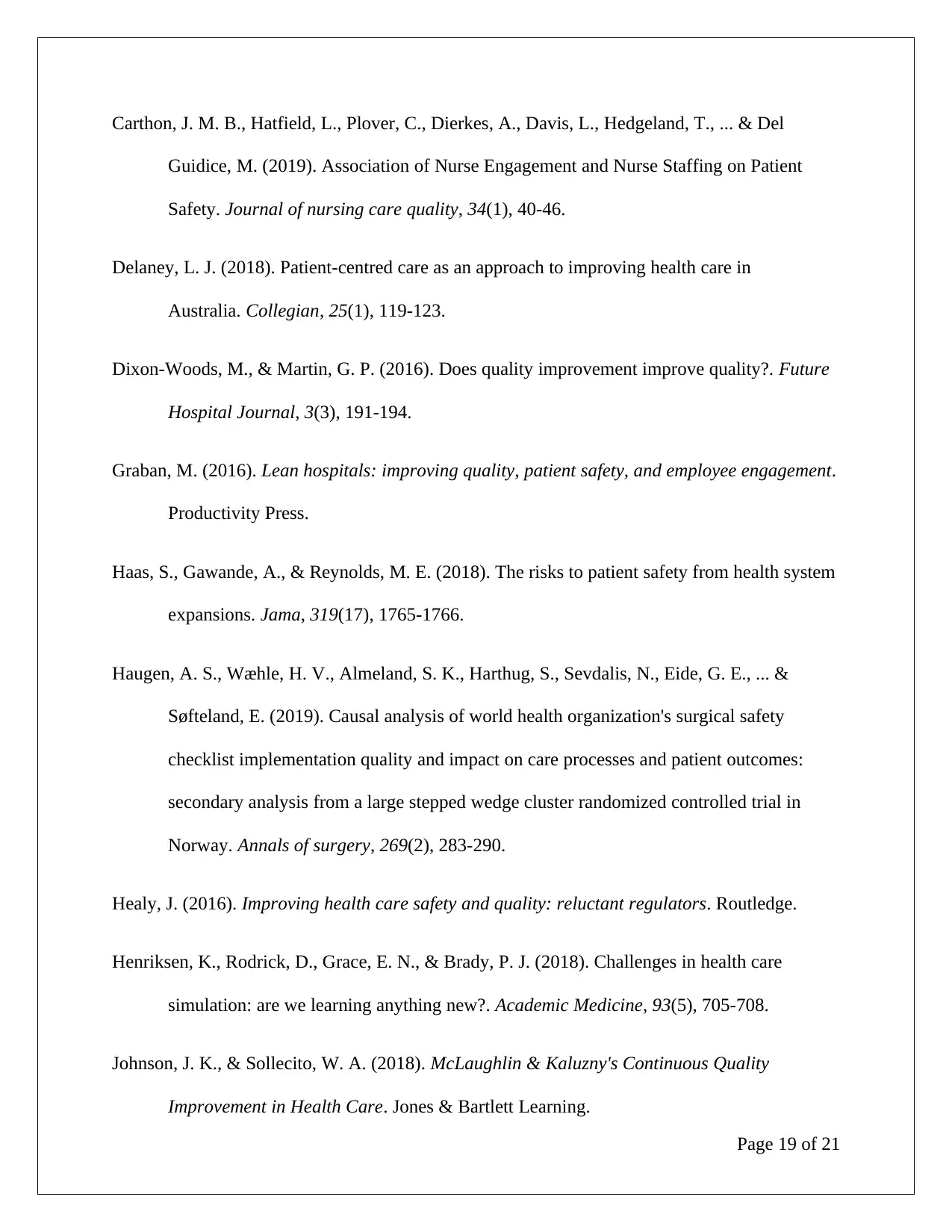
Carthon, J. M. B., Hatfield, L., Plover, C., Dierkes, A., Davis, L., Hedgeland, T., ... & Del
Guidice, M. (2019). Association of Nurse Engagement and Nurse Staffing on Patient
Safety. Journal of nursing care quality, 34(1), 40-46.
Delaney, L. J. (2018). Patient-centred care as an approach to improving health care in
Australia. Collegian, 25(1), 119-123.
Dixon-Woods, M., & Martin, G. P. (2016). Does quality improvement improve quality?. Future
Hospital Journal, 3(3), 191-194.
Graban, M. (2016). Lean hospitals: improving quality, patient safety, and employee engagement.
Productivity Press.
Haas, S., Gawande, A., & Reynolds, M. E. (2018). The risks to patient safety from health system
expansions. Jama, 319(17), 1765-1766.
Haugen, A. S., Wæhle, H. V., Almeland, S. K., Harthug, S., Sevdalis, N., Eide, G. E., ... &
Søfteland, E. (2019). Causal analysis of world health organization's surgical safety
checklist implementation quality and impact on care processes and patient outcomes:
secondary analysis from a large stepped wedge cluster randomized controlled trial in
Norway. Annals of surgery, 269(2), 283-290.
Healy, J. (2016). Improving health care safety and quality: reluctant regulators. Routledge.
Henriksen, K., Rodrick, D., Grace, E. N., & Brady, P. J. (2018). Challenges in health care
simulation: are we learning anything new?. Academic Medicine, 93(5), 705-708.
Johnson, J. K., & Sollecito, W. A. (2018). McLaughlin & Kaluzny's Continuous Quality
Improvement in Health Care. Jones & Bartlett Learning.
Page 19 of 21
Guidice, M. (2019). Association of Nurse Engagement and Nurse Staffing on Patient
Safety. Journal of nursing care quality, 34(1), 40-46.
Delaney, L. J. (2018). Patient-centred care as an approach to improving health care in
Australia. Collegian, 25(1), 119-123.
Dixon-Woods, M., & Martin, G. P. (2016). Does quality improvement improve quality?. Future
Hospital Journal, 3(3), 191-194.
Graban, M. (2016). Lean hospitals: improving quality, patient safety, and employee engagement.
Productivity Press.
Haas, S., Gawande, A., & Reynolds, M. E. (2018). The risks to patient safety from health system
expansions. Jama, 319(17), 1765-1766.
Haugen, A. S., Wæhle, H. V., Almeland, S. K., Harthug, S., Sevdalis, N., Eide, G. E., ... &
Søfteland, E. (2019). Causal analysis of world health organization's surgical safety
checklist implementation quality and impact on care processes and patient outcomes:
secondary analysis from a large stepped wedge cluster randomized controlled trial in
Norway. Annals of surgery, 269(2), 283-290.
Healy, J. (2016). Improving health care safety and quality: reluctant regulators. Routledge.
Henriksen, K., Rodrick, D., Grace, E. N., & Brady, P. J. (2018). Challenges in health care
simulation: are we learning anything new?. Academic Medicine, 93(5), 705-708.
Johnson, J. K., & Sollecito, W. A. (2018). McLaughlin & Kaluzny's Continuous Quality
Improvement in Health Care. Jones & Bartlett Learning.
Page 19 of 21
Paraphrase This Document
Need a fresh take? Get an instant paraphrase of this document with our AI Paraphraser
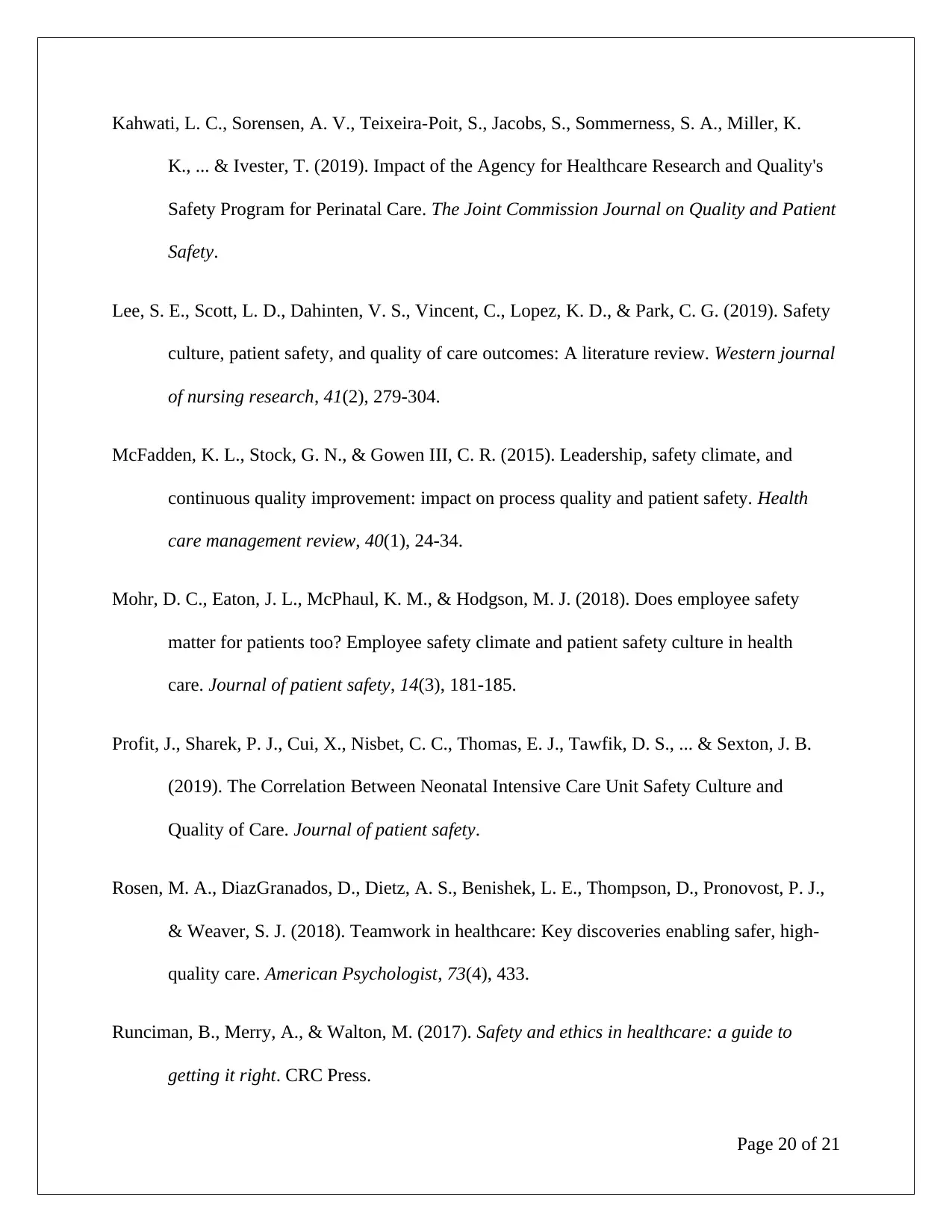
Kahwati, L. C., Sorensen, A. V., Teixeira-Poit, S., Jacobs, S., Sommerness, S. A., Miller, K.
K., ... & Ivester, T. (2019). Impact of the Agency for Healthcare Research and Quality's
Safety Program for Perinatal Care. The Joint Commission Journal on Quality and Patient
Safety.
Lee, S. E., Scott, L. D., Dahinten, V. S., Vincent, C., Lopez, K. D., & Park, C. G. (2019). Safety
culture, patient safety, and quality of care outcomes: A literature review. Western journal
of nursing research, 41(2), 279-304.
McFadden, K. L., Stock, G. N., & Gowen III, C. R. (2015). Leadership, safety climate, and
continuous quality improvement: impact on process quality and patient safety. Health
care management review, 40(1), 24-34.
Mohr, D. C., Eaton, J. L., McPhaul, K. M., & Hodgson, M. J. (2018). Does employee safety
matter for patients too? Employee safety climate and patient safety culture in health
care. Journal of patient safety, 14(3), 181-185.
Profit, J., Sharek, P. J., Cui, X., Nisbet, C. C., Thomas, E. J., Tawfik, D. S., ... & Sexton, J. B.
(2019). The Correlation Between Neonatal Intensive Care Unit Safety Culture and
Quality of Care. Journal of patient safety.
Rosen, M. A., DiazGranados, D., Dietz, A. S., Benishek, L. E., Thompson, D., Pronovost, P. J.,
& Weaver, S. J. (2018). Teamwork in healthcare: Key discoveries enabling safer, high-
quality care. American Psychologist, 73(4), 433.
Runciman, B., Merry, A., & Walton, M. (2017). Safety and ethics in healthcare: a guide to
getting it right. CRC Press.
Page 20 of 21
K., ... & Ivester, T. (2019). Impact of the Agency for Healthcare Research and Quality's
Safety Program for Perinatal Care. The Joint Commission Journal on Quality and Patient
Safety.
Lee, S. E., Scott, L. D., Dahinten, V. S., Vincent, C., Lopez, K. D., & Park, C. G. (2019). Safety
culture, patient safety, and quality of care outcomes: A literature review. Western journal
of nursing research, 41(2), 279-304.
McFadden, K. L., Stock, G. N., & Gowen III, C. R. (2015). Leadership, safety climate, and
continuous quality improvement: impact on process quality and patient safety. Health
care management review, 40(1), 24-34.
Mohr, D. C., Eaton, J. L., McPhaul, K. M., & Hodgson, M. J. (2018). Does employee safety
matter for patients too? Employee safety climate and patient safety culture in health
care. Journal of patient safety, 14(3), 181-185.
Profit, J., Sharek, P. J., Cui, X., Nisbet, C. C., Thomas, E. J., Tawfik, D. S., ... & Sexton, J. B.
(2019). The Correlation Between Neonatal Intensive Care Unit Safety Culture and
Quality of Care. Journal of patient safety.
Rosen, M. A., DiazGranados, D., Dietz, A. S., Benishek, L. E., Thompson, D., Pronovost, P. J.,
& Weaver, S. J. (2018). Teamwork in healthcare: Key discoveries enabling safer, high-
quality care. American Psychologist, 73(4), 433.
Runciman, B., Merry, A., & Walton, M. (2017). Safety and ethics in healthcare: a guide to
getting it right. CRC Press.
Page 20 of 21
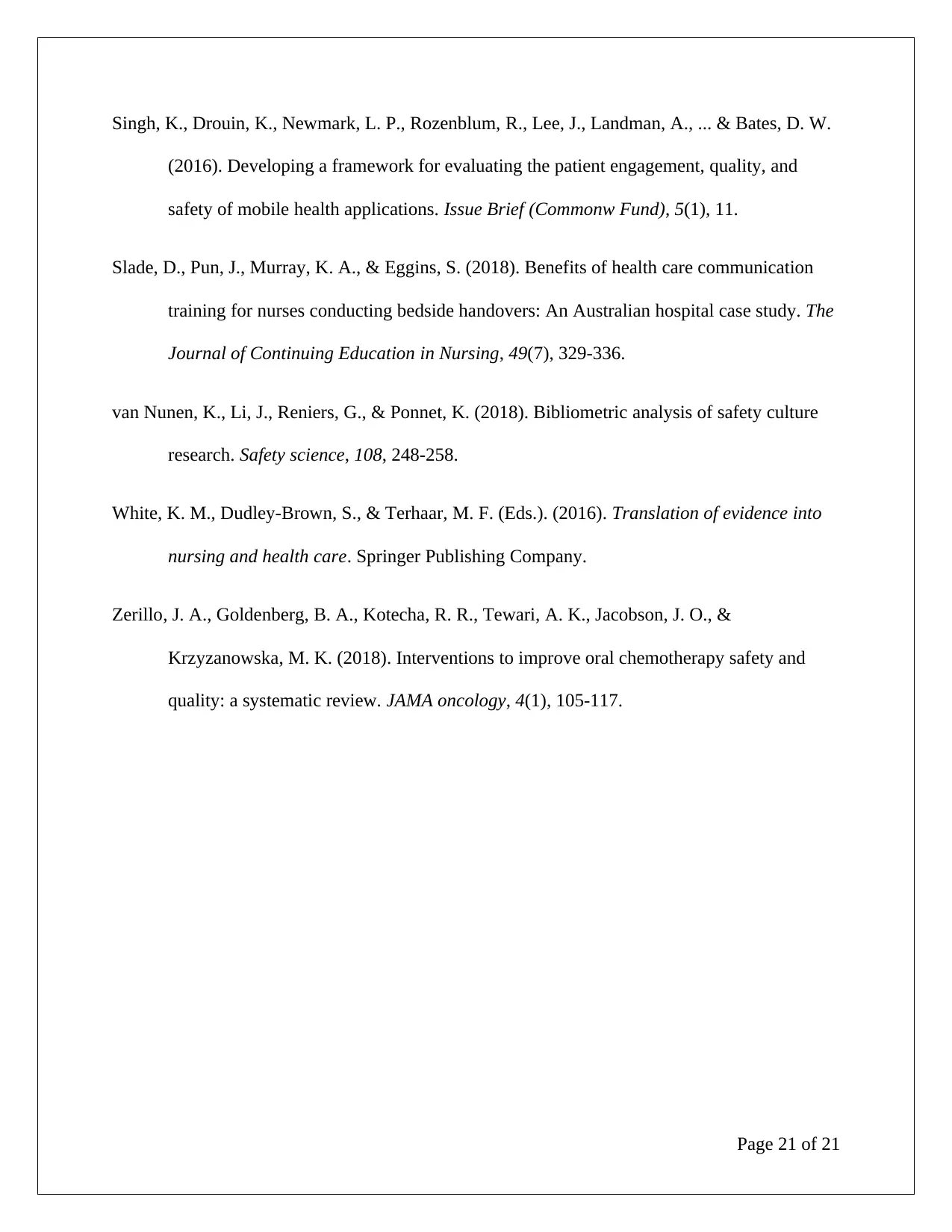
Singh, K., Drouin, K., Newmark, L. P., Rozenblum, R., Lee, J., Landman, A., ... & Bates, D. W.
(2016). Developing a framework for evaluating the patient engagement, quality, and
safety of mobile health applications. Issue Brief (Commonw Fund), 5(1), 11.
Slade, D., Pun, J., Murray, K. A., & Eggins, S. (2018). Benefits of health care communication
training for nurses conducting bedside handovers: An Australian hospital case study. The
Journal of Continuing Education in Nursing, 49(7), 329-336.
van Nunen, K., Li, J., Reniers, G., & Ponnet, K. (2018). Bibliometric analysis of safety culture
research. Safety science, 108, 248-258.
White, K. M., Dudley-Brown, S., & Terhaar, M. F. (Eds.). (2016). Translation of evidence into
nursing and health care. Springer Publishing Company.
Zerillo, J. A., Goldenberg, B. A., Kotecha, R. R., Tewari, A. K., Jacobson, J. O., &
Krzyzanowska, M. K. (2018). Interventions to improve oral chemotherapy safety and
quality: a systematic review. JAMA oncology, 4(1), 105-117.
Page 21 of 21
(2016). Developing a framework for evaluating the patient engagement, quality, and
safety of mobile health applications. Issue Brief (Commonw Fund), 5(1), 11.
Slade, D., Pun, J., Murray, K. A., & Eggins, S. (2018). Benefits of health care communication
training for nurses conducting bedside handovers: An Australian hospital case study. The
Journal of Continuing Education in Nursing, 49(7), 329-336.
van Nunen, K., Li, J., Reniers, G., & Ponnet, K. (2018). Bibliometric analysis of safety culture
research. Safety science, 108, 248-258.
White, K. M., Dudley-Brown, S., & Terhaar, M. F. (Eds.). (2016). Translation of evidence into
nursing and health care. Springer Publishing Company.
Zerillo, J. A., Goldenberg, B. A., Kotecha, R. R., Tewari, A. K., Jacobson, J. O., &
Krzyzanowska, M. K. (2018). Interventions to improve oral chemotherapy safety and
quality: a systematic review. JAMA oncology, 4(1), 105-117.
Page 21 of 21
You're viewing a preview
Unlock full access by subscribing today!
1 out of 21
Related Documents
Your All-in-One AI-Powered Toolkit for Academic Success.
+13062052269
info@desklib.com
Available 24*7 on WhatsApp / Email
![[object Object]](/_next/static/media/star-bottom.7253800d.svg)
Unlock your academic potential
© 2024 | Zucol Services PVT LTD | All rights reserved.





